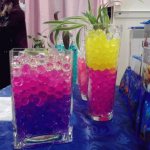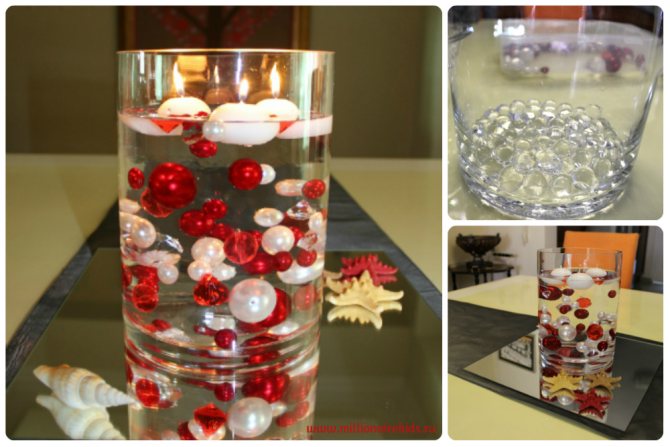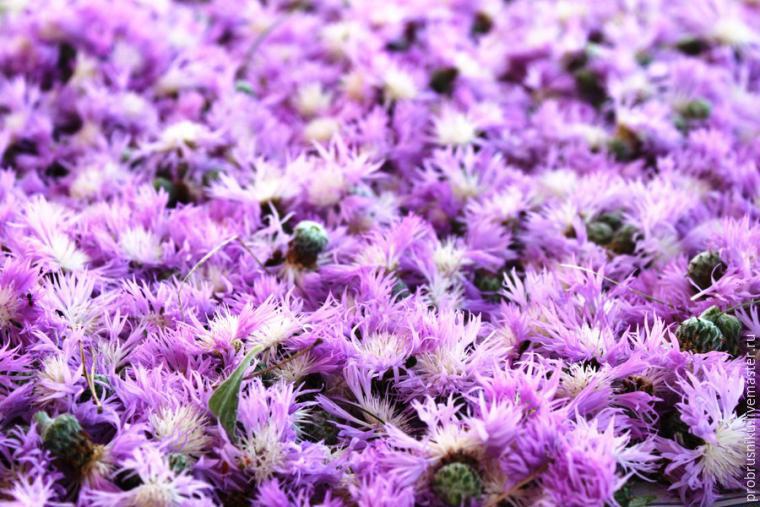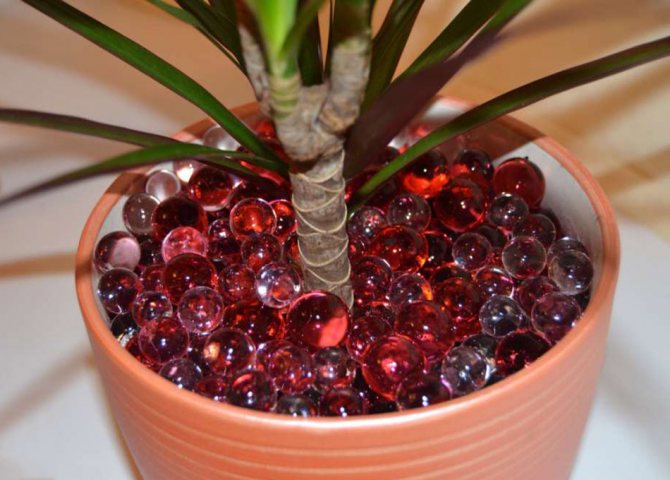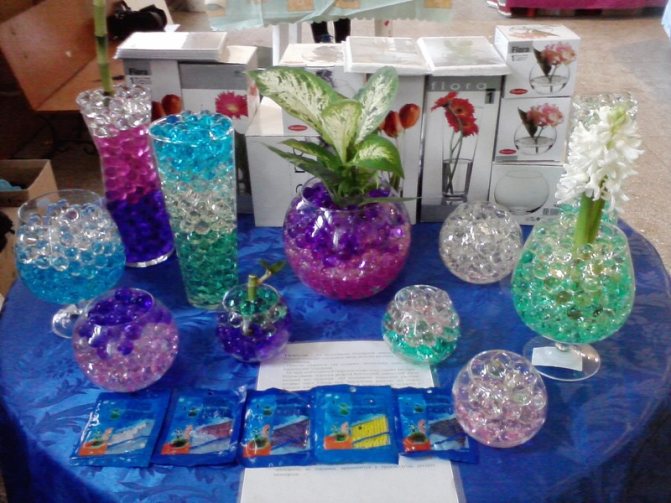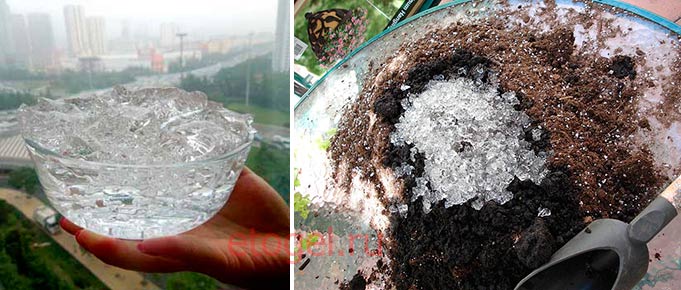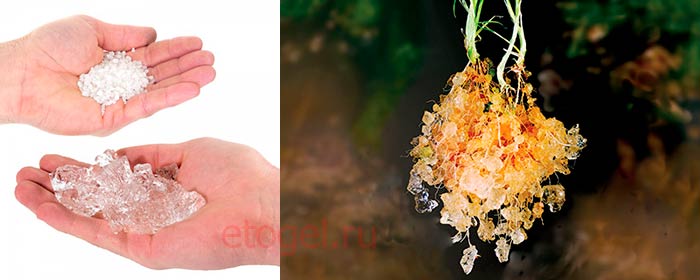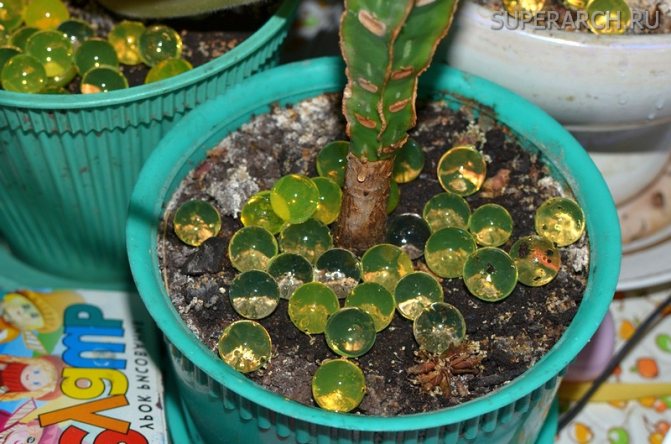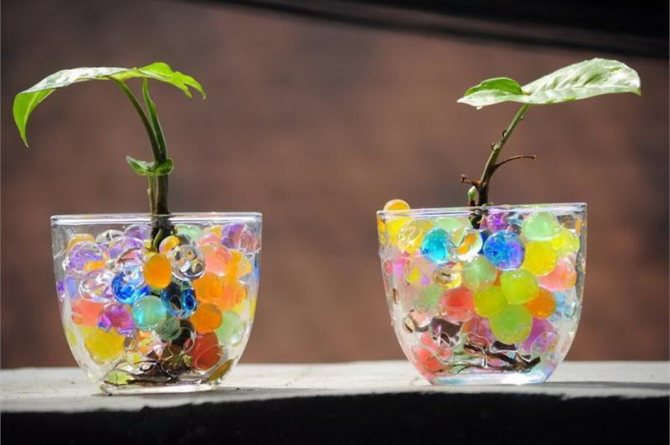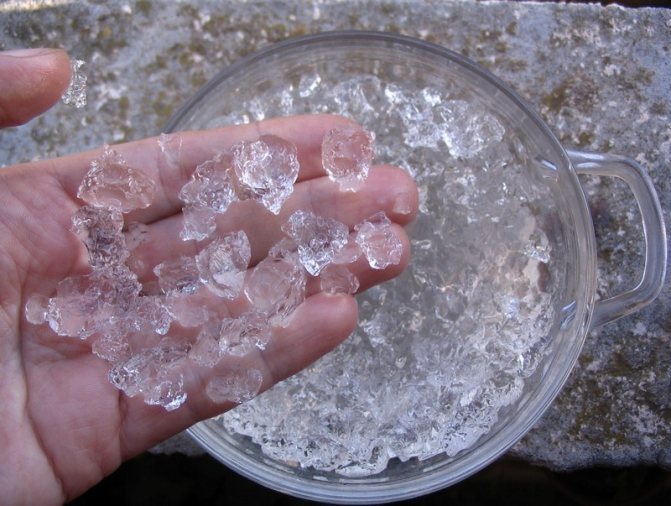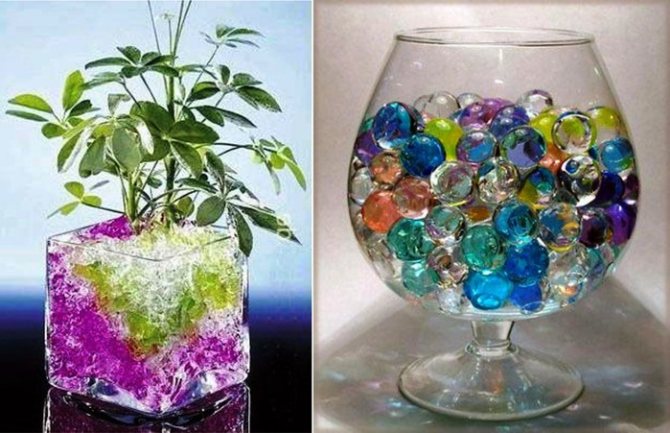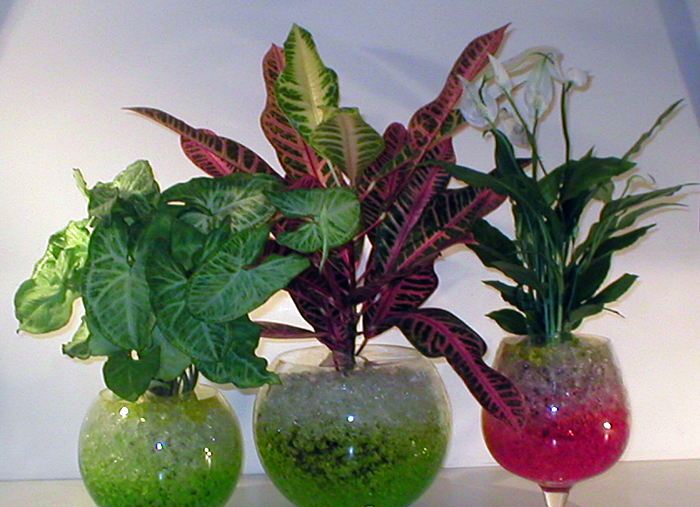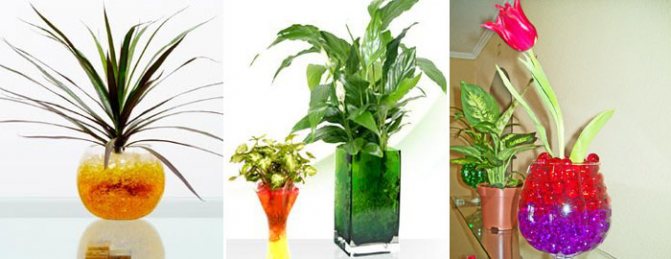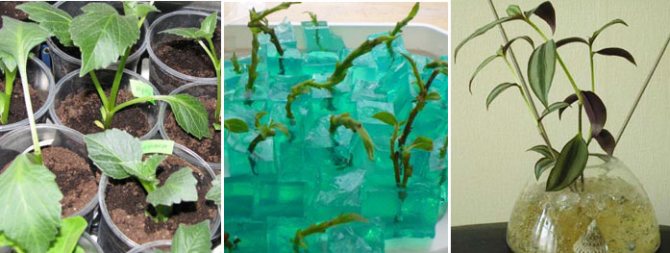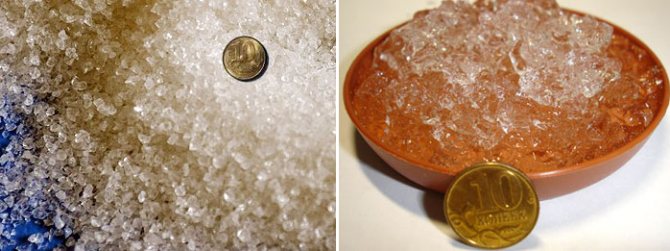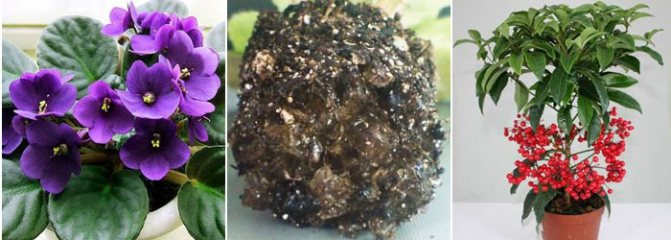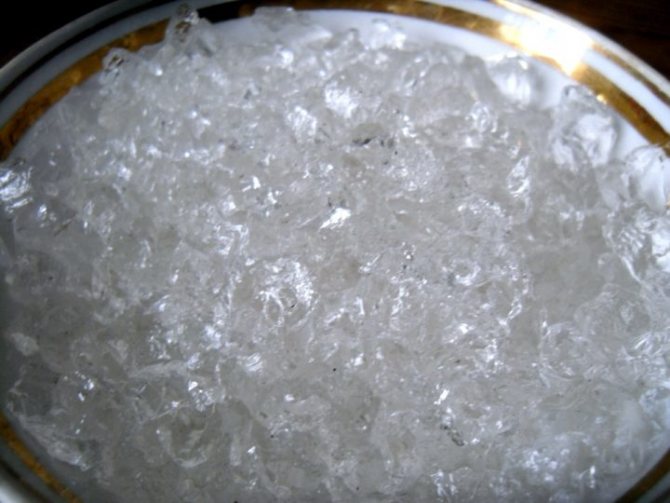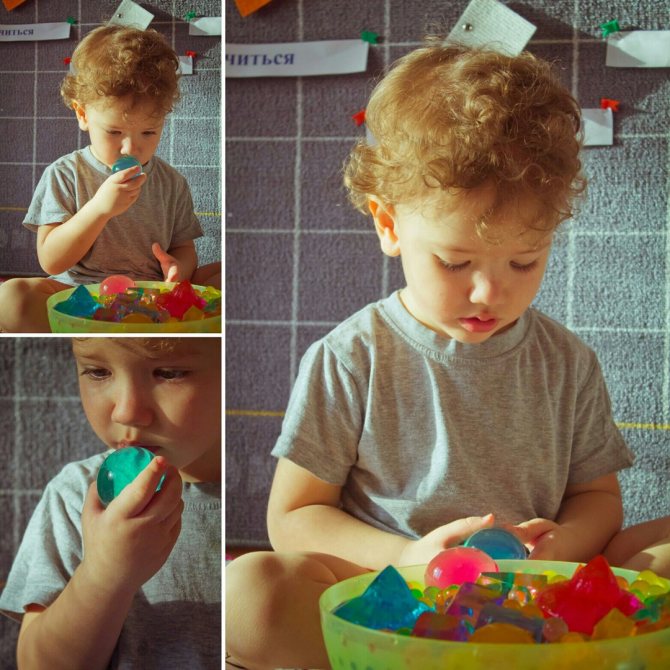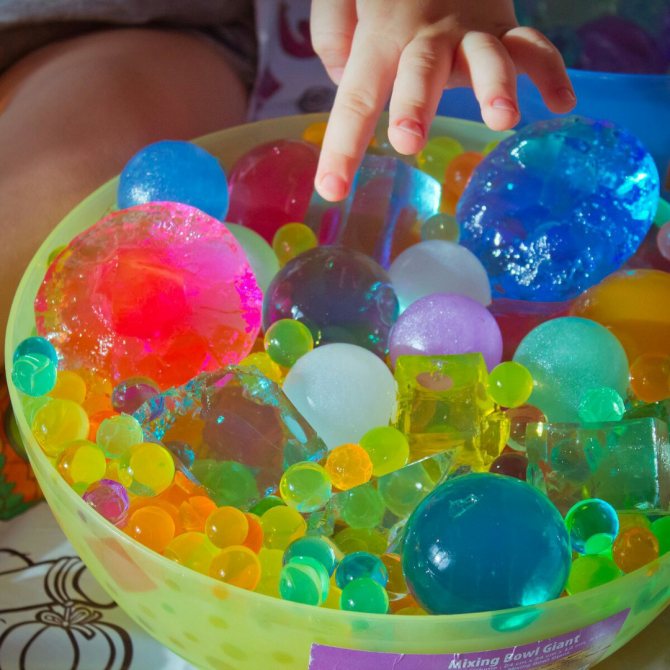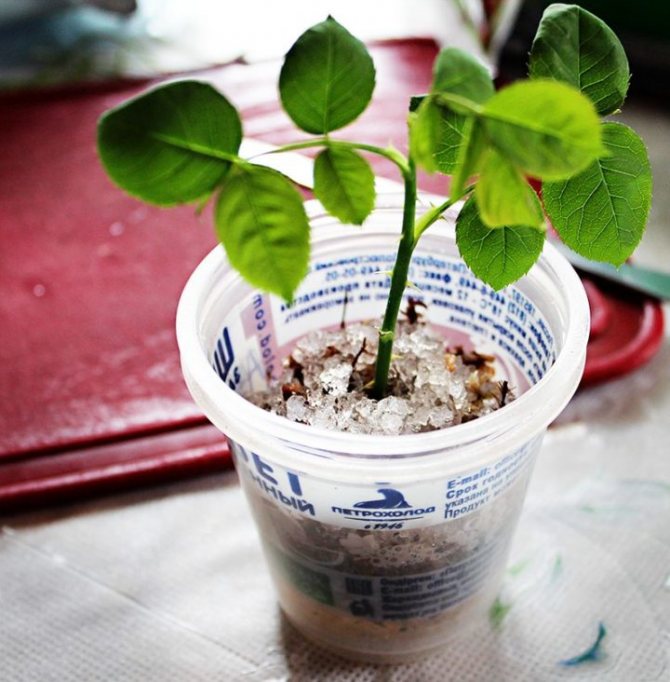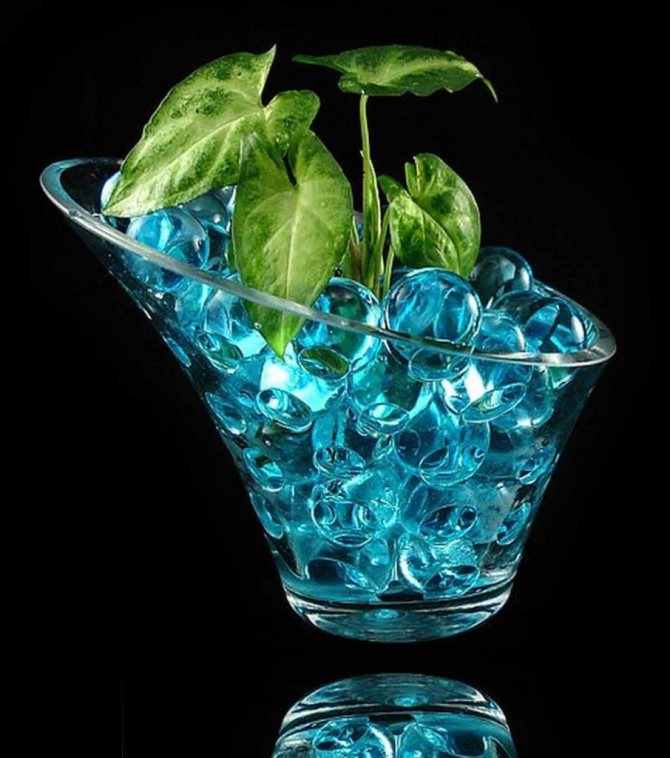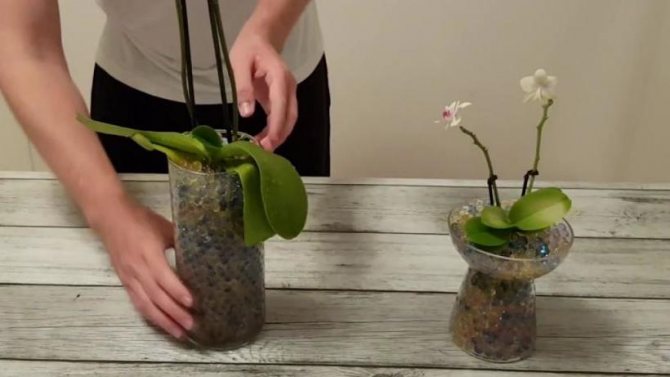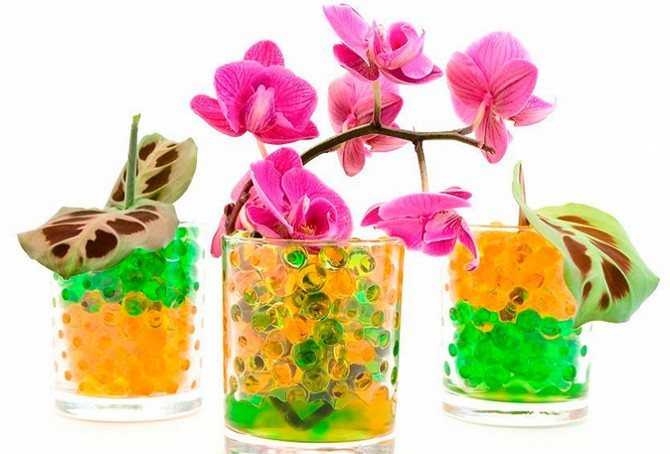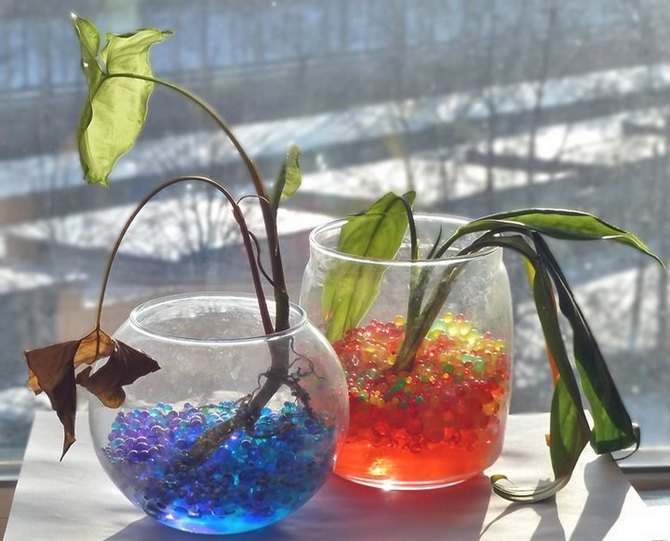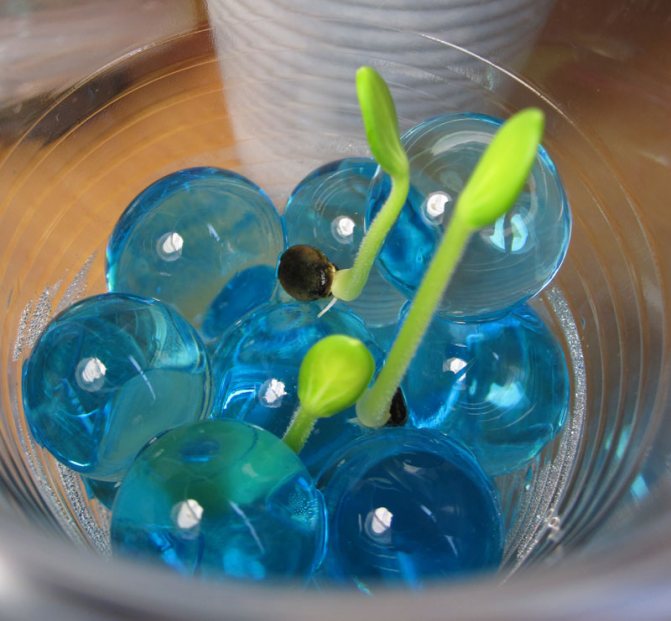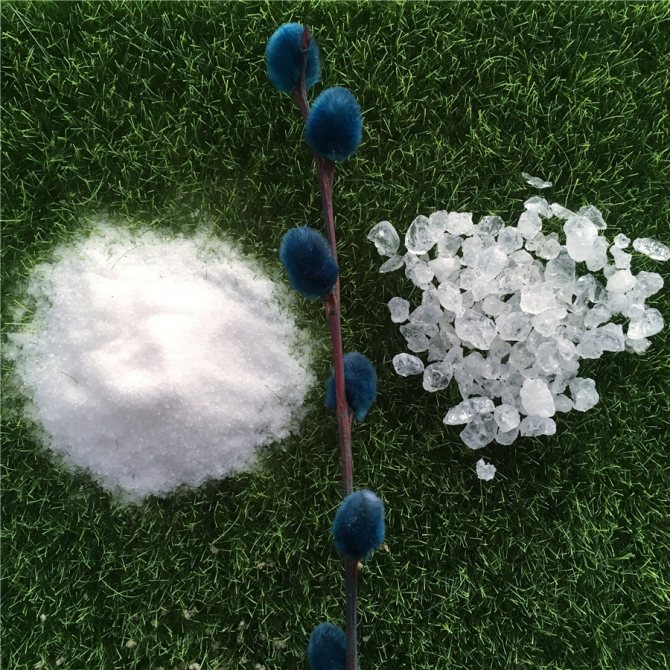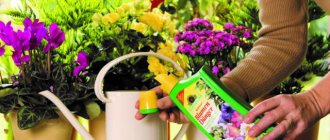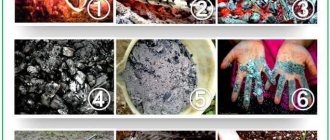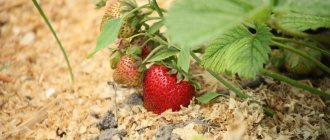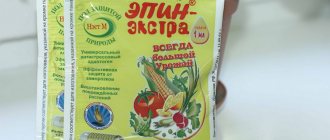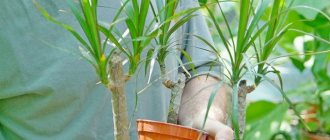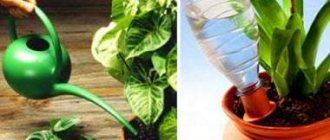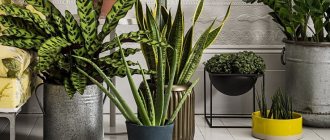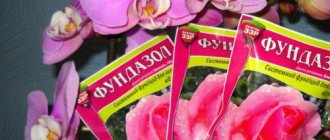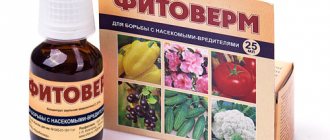Hydrogel properties
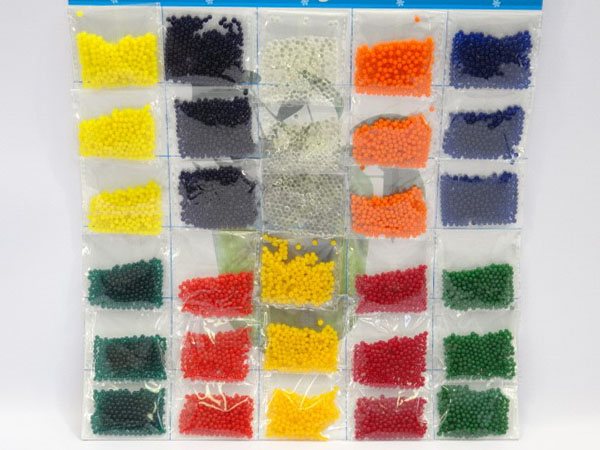
A hydrogel is a polymeric substance in granular or powder form. It is characterized by the following qualities:
- the hydrogel formula retains moisture and added top dressing;
- positively affects the structure of the soil;
- prevents the appearance of cracks on the soil surface;
- promotes abundant flowering and fruiting.
- long term of validity (about 5 years).
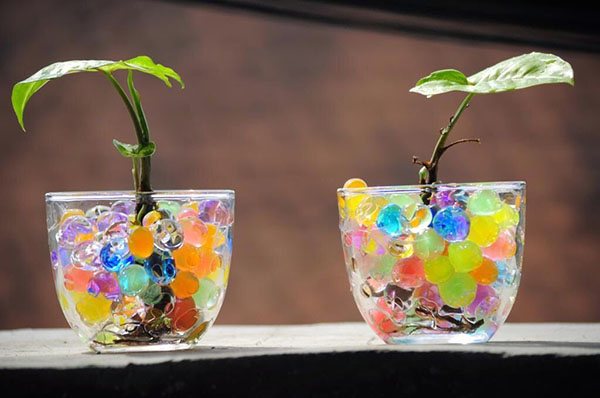

Interacting with water, the hydrogel swells and increases in volume several times. The finished substance should be mixed with the soil and the plant should be planted in the substrate. Upon germination, the root system will be hydrated without additional watering for 15-20 days. The thicker the roots, the longer it won't need watering. After watering, the balls grow again without losing their functionality.
Varieties and composition of hydrogel for plants
There are two types of plant hydrogel:
- Soft. It is used for planting houseplants, germinating seeds and planting garden crops. Thanks to the softness of the granules, it is ideal for vegetation with a delicate root system. The roots grow inside the balls and are saturated with moisture.
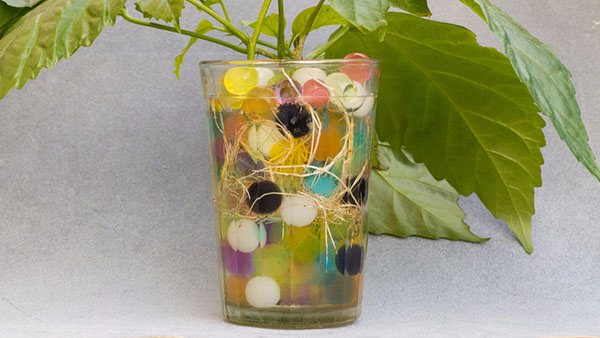

- Dense (aqua soil). Its characteristic feature is multicolored or shiny granules. Used as a decoration for flower pots.
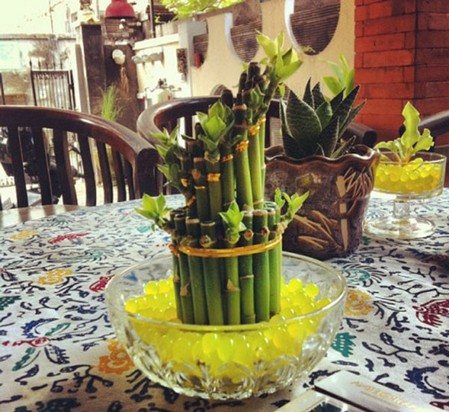

Aqua soil is not suitable for growing flowers. It can only be used for decorative purposes, for example, for bouquets placed in a transparent vase.
These types of hydrogels are widely used by flower growers and designers because they have many advantages over conventional soil.
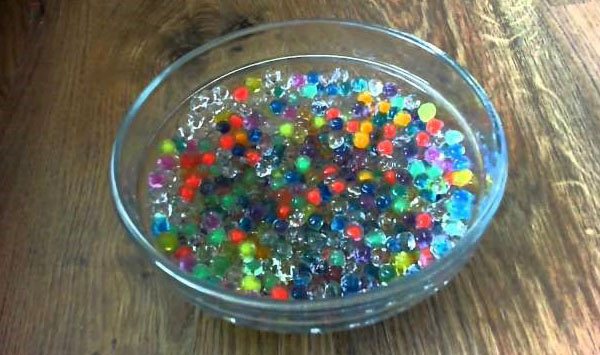

The chemical composition of the hydrogel for plants does not contain toxic elements and is completely safe for human and plant health. After the end of their operational life, the components disintegrate and turn into organic substances.
What can be done from orbiz?
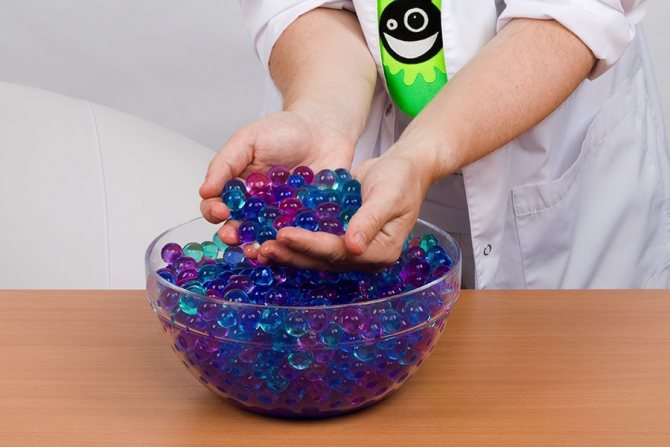

0
If the baby is afraid to swim, throw hydrogel balls into his bathtub, and he will happily climb up to play with them. Take multi-colored orbis and crush them in a bowl. This can be done by hand, but it is better to take, for example, a mashed potato crusher; Now, from the crushed pieces, you can lay out any picture with the baby. Perhaps for older children this will seem a very simple exercise, but for kids 3-5 years old, it will work. They are happy to poke their fingers in transparent soft pieces and lay out bright drawings from them on a plate.
Given the low price of the product, some parents buy them in huge quantities and fill the whole bathroom with them. Any child will be delighted with such bathing, and not only a child.
Advantages and disadvantages
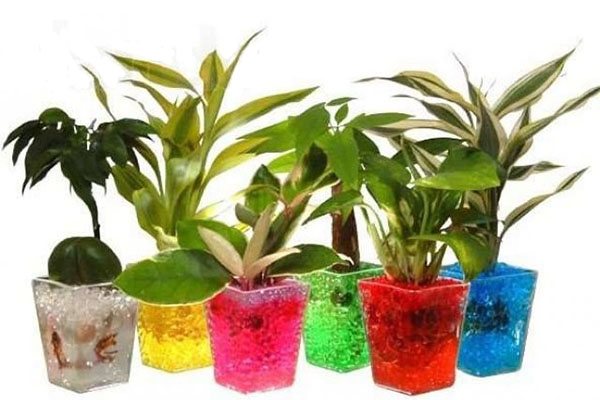

The positive qualities of a hydrogel for plants include:
The substance has few disadvantages:
- the composition of the hydrogel is not suitable for the germination of legumes and sweet peas;
- prolonged exposure to the sun can lead to mold;
- if used in pure form, it should be changed every two years.
To make sure of the effectiveness of the granules, it is worth applying it on your own area or house plants.
Composition of the product and application
Before purchasing a hydrogel for plants, gardeners and florists recommend studying its composition in more detail. This is necessary to make sure that the product is safe to use.
Note! A good gel will not only saturate the roots of plants with moisture, but will help to improve the quality of the soil.
Saves the amount of mineral dressings, and also does not require constant replacement due to the long shelf life.
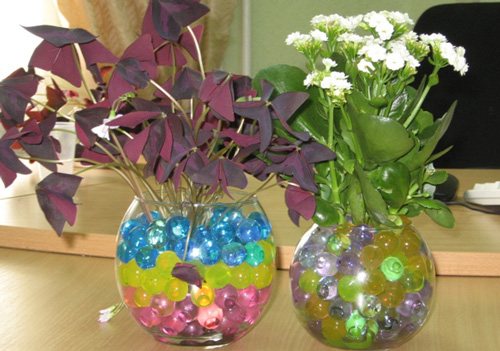

The photo clearly shows what shapes and sizes the tool can be, in order to get to know it better - consider the composition in more detail:
| Component | Description |
| Acrylamide | Component capable of retaining water for a long time and also dries quickly |
| Potassium polyacrylate | It is this component that causes the reaction of absorbing a large amount of moisture. So, 1 gram of hydrogel is capable of absorbing 300 milliliters of liquid at once. |
This component is widely used in the manufacture of diapers.
Terms of use
Before using the hydrogel in the garden or for planting indoor flowers, it is worth giving it time to swell by placing it in a spacious open container. If the balls are added dry, when they swell, they can push the plant to the surface.
Growing greens
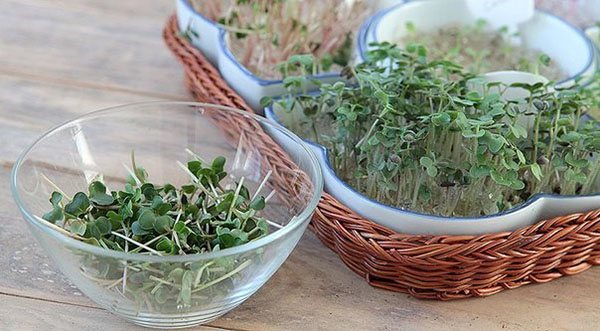

Greens contain many trace elements, so eating every day has a positive effect on the body. The fine fraction Stockosorb hydrogel makes it possible to create a mini-vegetable garden on the windowsill.
This will require:
- Pour the substance into a large container and add water for several hours.
- After swelling, remove excess water by discarding in a colander.
- Distribute the material to the planting pots.
- Spread dry seed on the surface without deepening.
- After waiting for a suitable seedling size, harvest the crop.
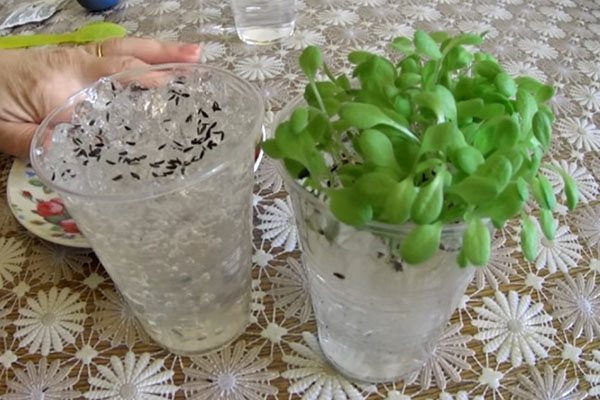

After that, you can replant the vegetation in the container.
Transplanting flowers
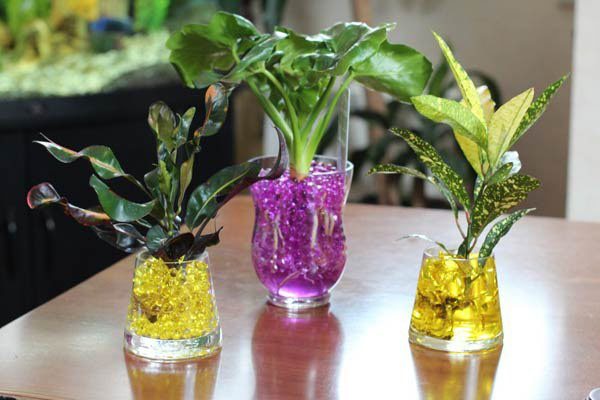

The instructions for use of the hydrogel involve pre-soaking before adding it to the flower.
A step-by-step guide to action consists of the following points:
- remove the plant from the container along with the earthen clod;
- remove excess soil without damaging the root system;
- rinse the roots under running water;
- pour drainage and some soil into a new container;
- place the flower in a pot, straighten the roots;
- fill the pot to the brim with soil mixed with the hydrogel.
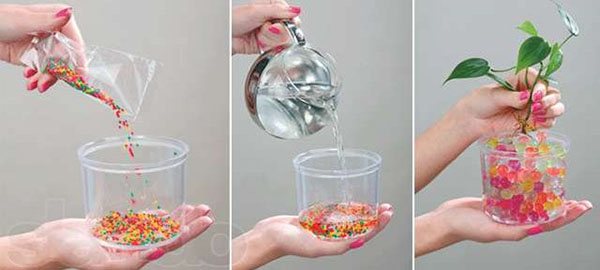

After completing the transplanting operations, spray the surface with water, and then do not water for the next 10 days.
Gardening and horticulture
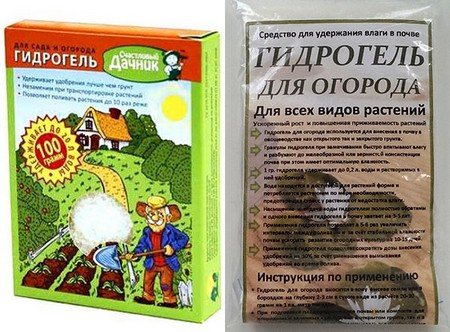

In horticulture, the balls are used dry for grafting shrubs, rooting, transplanting seedlings in a ratio of 1 to 5. With the help of this substance, the soil is saturated with nutrients, loosening of dense soil and an increase in oxygen availability. The pellets can be dug around the trunks of already mature trees and bushes.
You should also figure out what a hydrogel for a garden is and how to use it correctly. It is ideal for germinating seeds, growing seedlings outdoors until flowering.
Granules saturated with top dressing will increase the fruiting of plants, protect them from diseases and are suitable for the following crops:
Before planting plants, it is necessary to place the balls into the soil to a depth of 5 cm at the rate of 20 g of dry matter per 1 sq. m.
When using a hydrogel, it is important not to flood the plant, so you should water the soil no more than once every two weeks.
Precautions and features of use
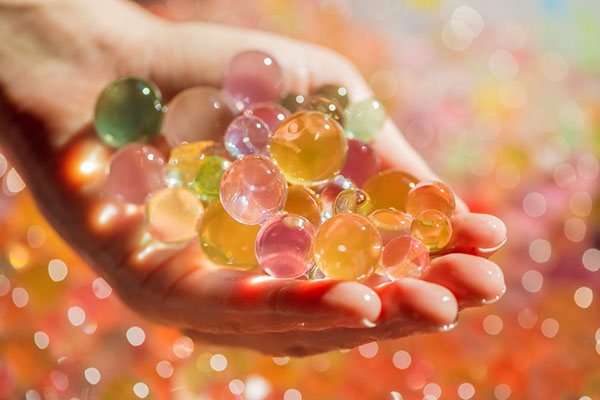

In order for the substance not to lose its original qualities, it is necessary to adhere to certain recommendations:
- The substance should not be exposed to direct rays of the sun. As a result, microscopic algae may appear inside the balls.
- Water the potted plant once every 14 days, immediately removing excess water from the pan.
- Before using the hydrogel for indoor flowers, it must be allowed to swell. Do not pour dry matter into a closed container.
- For large flowers, it is worth using a limited amount of substance. Otherwise, without support, the plant may fall.
- When using a pure hydrogel, the planting container should be transparent;
- Before diluting the hydrogel, it is necessary to prepare settled or distilled water.
- Planting seeds for seedlings should be done in a pre-crushed gel.
- Watering should be carried out five times less often than in the presence of land. The lack of moisture leads to the sedimentation of the substance, therefore the lack of water is visible to the naked eye.
Read also: How to get rid of ants in a greenhouse, folk remedies, video
Having figured out what a hydrogel is for, you can use it to grow various varieties of indoor plants and decorate flower arrangements. Before planting, it is worth remembering that aqua soil cannot be used for long-term planting. For these purposes, white hydrogel granules are used.
Growing flowers in a hydrogel - video
balls growing and growing in water
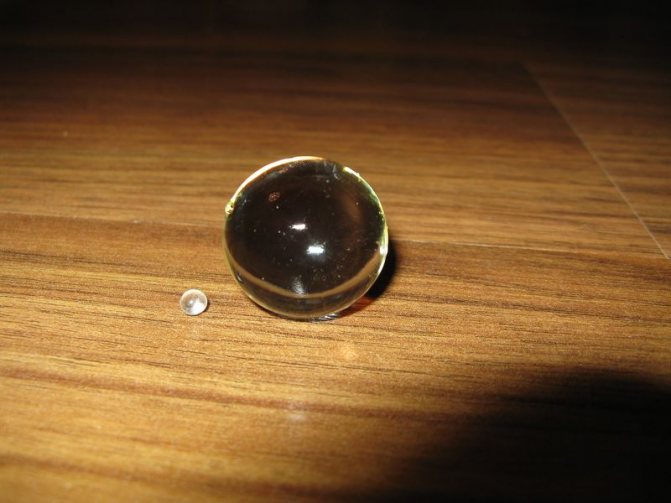

Balls growing in water (Both types of beads are available.) Have several applications. I would like to clarify one thing right away.
Original size: 1-2 mm, increased to 1.5-2.5 cm. You will receive a package with 160 balloons inside depending on the selected option / color of balloons (you can choose. Above, to the right of the photo). Transparent balls increase 1.5 times more than luminous. Luminous (light-accumulating) balls glow brightly before magnification, much fainter after magnification. Before, there were various similar figurines / toys that also grew in water, but they only had to be placed in hot water, and after enlarging, those toy figures were almost shapeless because they were too soft. These
growing balls are of higher quality (after increasing, they certainly keep their shape, even jump).
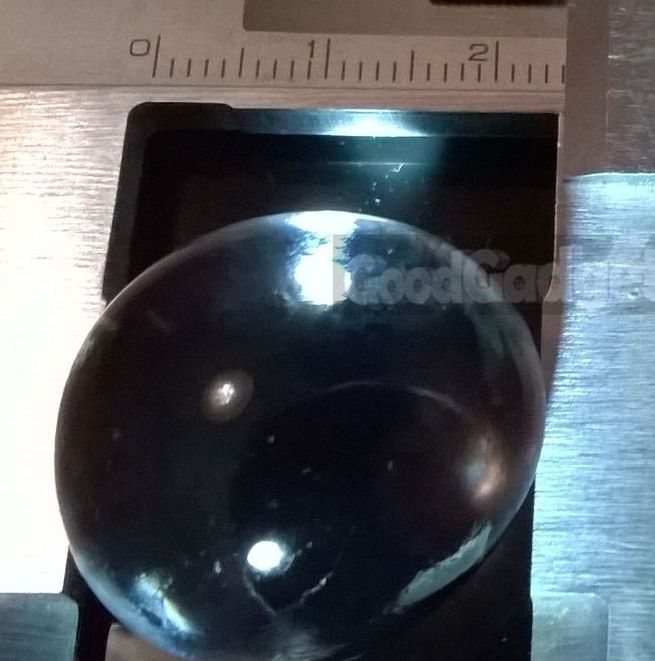

The main applications are decorative and very interesting - replacing soil for flowers, using balls growing in water instead of soil in flowers. First, I'll tell you more about the balls. Balls growing in water increase several times (from 2-3 mm (initial size) and up to 2-3 cm in diameter (after several hours in water)). To increase the balls, they need to be placed in a bowl with clean, preferably boiled (or even better, in general, with distilled) water for one night. In a bowl, if you pour out the whole bag at once, there should be at least 2 - 3 liters of water. The water in the bowl can be cold or hot. In hot water, the increase can be faster. Everyone growing ball consists of a special gel that can absorb water. Such a harmless gel can absorb 50 to 200 times its own weight of water. To achieve maximum effect (maximum possible size balls), you can leave the bowl with balls for a full 24 hours, but 8 hours is usually sufficient. After the balls absorb water, they will consist of more than 97% of water, but have the shape of balls, even jumping if thrown from a not very high height (up to a meter). The fact that the balls will consist almost entirely of water has a very interesting effect. Those balls that have a transparent color (being already increased) will be virtually invisible if placed back in water. You can show tricks: take a bowl with (already enlarged) balls placed in it, put your hand in a bowl of water, and, seemingly, from an empty bowl, take out transparent balls.
Video
After the balls have grown (at least 8 hours have passed), you can remove them from the bowl of water, or simply pour the water out of the bowl. The balls will remain at this size for a long time. Only after a few days, as the water evaporates from them, the balls will slowly decrease. They may shrink back to their original size.They can be placed in water again, the balls will grow again in a few hours. Each packet contains about 190 balls growing in water... A decent part of the balls will have a transparent color, you can experiment with the disappearance of transparent balls in a container with water. Why transparent, already enlarged ballsdisappearing into the water? 1. Balls consist of more than 97% of water, so they are almost water, but bound into a certain crystal lattice (having a form). Therefore, the balls are not visible in the water. 2 the answer to this question is that the colorless beads have a very high degree of transparency. I think some of you are aware of the fact that quality diamonds also disappear, being
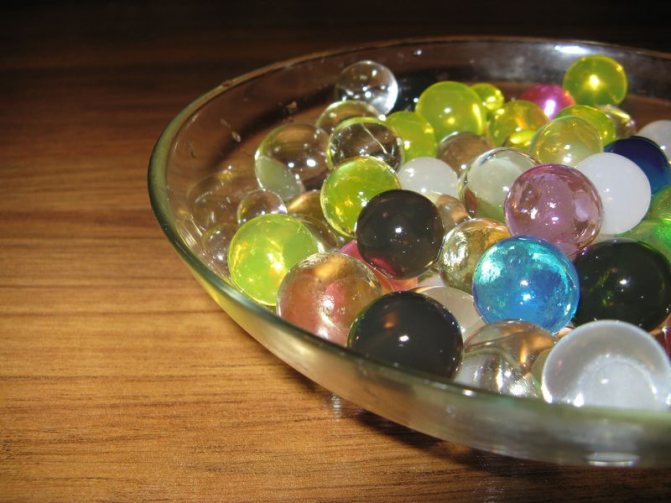

placed in water as they have a high degree of transparency. As a decorative use, growing balls can be quite helpful. You can, for example, sprinkle a few balls on a tray or plate, and place a candle in the center. You can decorate the objects being photographed with similar decorative elements. You can put these balls in a clear vase or glass. And now about the second option for using balls. You can plant or transplant flowers or other plants into glasses or other containers with these balls. Water is not required in the container, the plants will take moisture from the balls themselves. The soil will no longer be needed. You will see whether the plant needs to be watered or not. Depending on the size of the balls (they will shrink as the plant consumes moisture), you will know if the plant needs to be watered or not. As growing balls consist of more than 97% water, all the space occupied by the balls is water. That is why, the plant will not need to be watered for a long time (from a week or more). Further, a quite reasonable question arises: "How will the plant receive the trace elements and vitamins it needs?" 1. You can buy the necessary vitamins for your plant in specials. stores. 2. Some of the manufacturers of similar balls growing in water declare that the balls contain
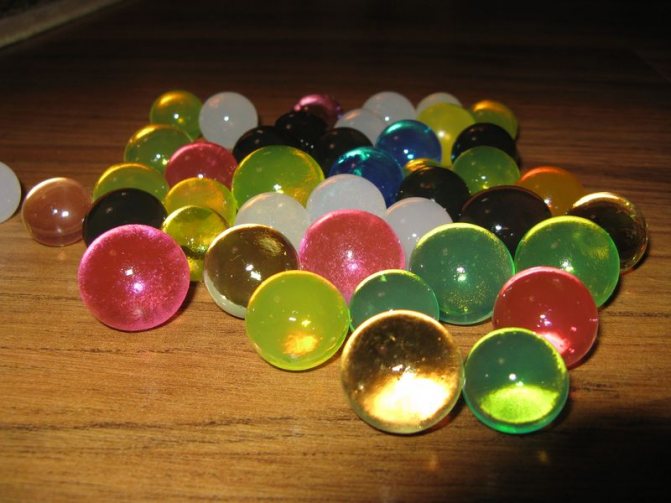

everything necessary for plants that the life of the balls is about a year. Perhaps it is. But this information has not yet been confirmed, it is better to play it safe with vitamins and extra. elements for your plant. I suggested that these balls growing in water can be used as silica gel. An experiment was carried out. Several balls, which had not yet grown, were placed in a closed container. A few drops of water were poured into the other part of the container. The container was sealed and left overnight. The water drops remained, the balls did not absorb a drop in the distance. It was planned that the balls would draw moisture from the surrounding air, thus lowering the humidity, a drop of water would quickly evaporate into the air, then be absorbed by the balls. This has not been confirmed. The experiment showed that the balls should be placed directly in water, and not next to it, only in this case, they will absorb water, increase in size.
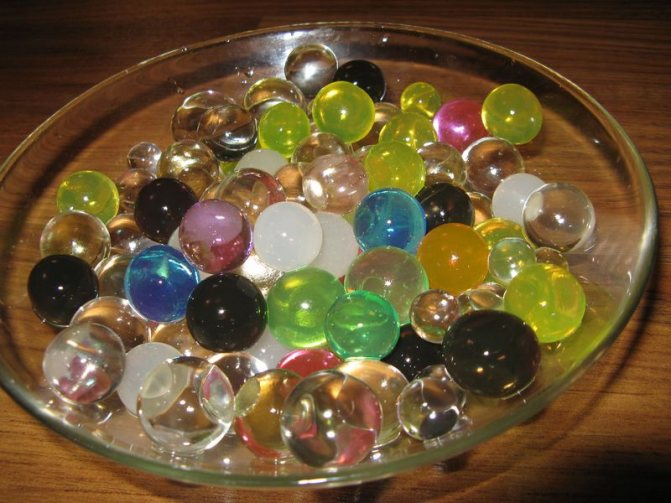

But while the balls are not silica gel, they can be used to absorb excess water. For example, you have a shelf with dishes, the water from the washed dishes flows down to a tray located under the shelf. If in this tray (in the place where water accumulates) you place several of these growing ballsthen all the water will be absorbed by them. This way, the tray will always be dry. There are many places where water accumulates, where you can also place similar balls, for example, glasses for toothbrushes. The balls are flexible enough. If you compress them, to a certain extent, they respond with elasticity, but with further compression, they crack, collapse.Hmm, you can show children such balls in biology lessons and say that they are looking at the children, this is approximately the same strength of the human eye, and what if you throw anything at each other (recently I saw how children threw each other with burning matches into a friend, some kind of horror), then, they say, what will happen to your eye if something gets into your eye. On this phrase, squeeze the ball so that it shatters into pieces.
Instructions:
1. Place the balls in a large (at least 2 liters or more) container with clean water (boiled or distilled) water. The water can be warm or cold (the reaction may be faster in warm water). 2. Leave this container for a few hours (minimum 8, for max. Ball size, 24 hours is possible). If the balls begin to spill over the edge of the container, pour them into a large container, add water, leave the balls to grow further. 3. Drain the water from the container (you can use a sieve). It is convenient to drain the water through a sieve because you can accidentally throw out transparent balls invisible in water with water. 4. Use
enlarged balls at your own discretion.
Using plants instead of soil
1.Choose a container in which your flower or other plant will grow. Of course, a transparent container will look more impressive. 2. Remove your plant / flower from the soil, clean (if necessary) wash it off the soil. 3. Place the plant in the chosen container, cover with the already enlarged balls. 4. As the plant consumes moisture, the balls will decrease in size. If necessary, add some water to restore the size of the balls (replenish the water supply). 5. The advantage of this use of balls is that they are more than 95% water, but they will not "drown" the plant, but will give it water slowly, just as the soil would give water to the plant. But unlike soil, which takes up a lot of space, balls are made up almost entirely of water and will be more efficient than soil. Thus, according to the manufacturers of balls, you can leave your plant for a week or more without adding water, the plant will take moisture from the balls and will not die. How long the plant will live on water balls is not known, you need to experiment. It is also not known whether you need to add specials. microelements and vitamins for plants. According to the suppliers, the balls already contain all the necessary substances, the life of the balls is about a year.
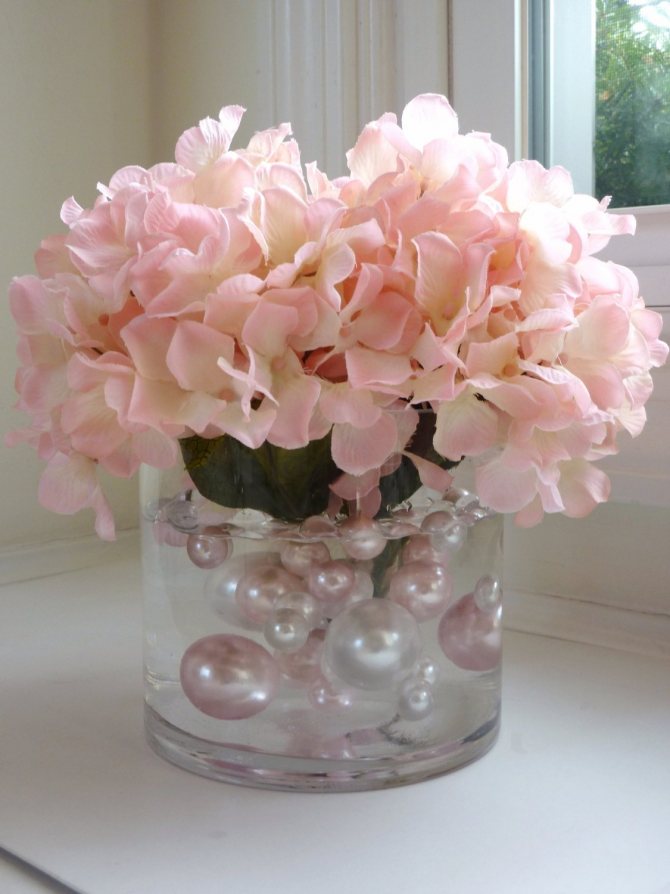

There is also a great way to use water balls. Transparent balls, since they are not visible in
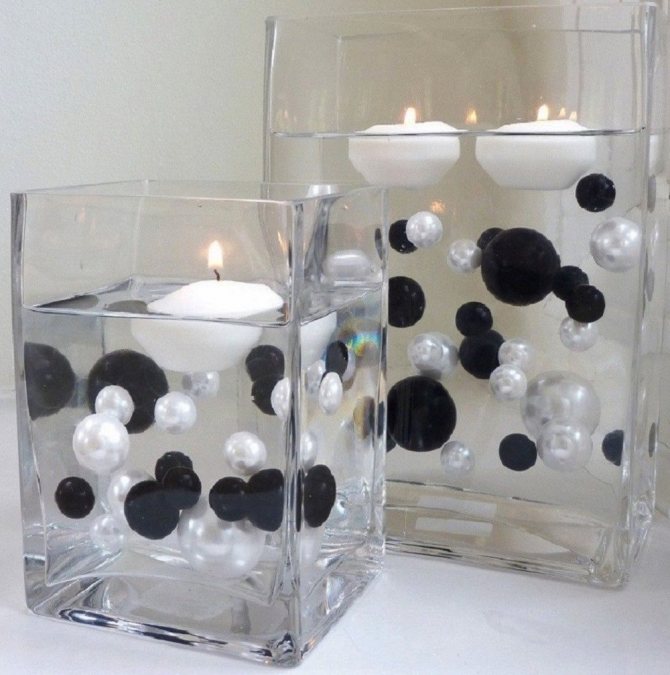

water, can be used with beads. You can mix the (already enlarged) transparent balls together with the beads. Since the transparent balls will not be visible in the water, the effect of beads hanging in the water is created. You can use beads of different or the same colors. In the photo on the left, you can see examples of a combination of transparent balls and beads. There should not be a lot of beads in order to maintain a thin space (between the beads). If there are too many beads, then the vessel with them will look as if beads were simply poured into it. If there are few beads, then they will, as it were, leveled (hover) in the water. Both glasses and large vases can be used as vessels. You can combine it both with flowers and with candles, etc. with decorative pieces :).
Hydrogel: what is it
Not everyone knows what a hydrogel is, although in recent years this substance has become more and more common among gardeners.
The hydrogel has a very simple composition - it is an ordinary polymer, crushed to a state of powder or granules of various shapes. Its main feature is the ability to absorb large amounts of moisture, which can then either simply evaporate or be absorbed by plants planted in this substance.Due to this, even the smallest balls can "swell" to a fairly large size.
On the question of what a hydrogel is and what it is needed for, there are several directions for its use at once:
- As a decorative multi-colored substance with which glass containers are filled and indoor plants are planted or poured into vases with freshly cut flowers.
- As a moisture-accumulating substance, thanks to which flowers can remain without watering for a long period of time.
- As a way to quickly and efficiently deliver nutrients to plant roots.
- As a substance for effective seed germination and rooting of cuttings.
Difference between hydrogel and aqua primer
Hydrogel and aqua primer are water-retaining polymers. Hydrogel was originally developed as a soil additive to reduce the frequency of watering. Outwardly, the substance is in the form of colorless granules or balls, which, when swollen, are deformed due to their lower density. Aqua primer is produced on the basis of a hydrogel for decorative use, produced in the form of multi-colored figures. The thicker consistency allows it to maintain its shape after soaking.
Aqua soil is not used for sowing seedlings and adding to the soil, since its moisture yield is much lower than that of a hydrogel.
Types of gel primers
Hydrogel for flowers has two common forms - soft and dense. They differ among themselves not only in their structure, but also in the directions of use, as well as in cost.
Soft hydrogel
The soft hydrogel for plants has the widest application.
It is added to soil mixtures for indoor flowers, for germinating seeds, for planting garden and garden plants. Due to the soft structure and small size of the granules, the roots of any plant can easily penetrate between the granules and into them, while sucking out moisture and minerals.
This substance is colorless and very rarely used on its own. Often it is mixed with soil substrates, which prevents both soil acidification from the introduction of a large amount of moisture and its rapid drying.
Dense hydrogel (aqua soil)
This is a more expensive material, which can consist of granules that are larger and more varied in shape.
Due to the high cost, aqua soil is completely irrational to use in truck farming and horticulture. Unlike a regular hydrogel, aqua primer can include a variety of dyes, glitters and rhinestones. In this regard, the answer to the question of how to use aqua soil appears by itself - it is used to decorate transparent flower pots, as well as create attractive florariums.
Another way to use aqua soil is to refresh the air. For this purpose, dry granules are filled with water with essential oils or another liquid that has a pleasant aroma. Once the moisture has been absorbed into the granules, they can be placed in glass containers throughout the house and smelled long enough. In addition, if children or pets accidentally overturn a pot or vase with a dense hydrogel, it can be quickly put back together, and you don't even have to vacuum the house.
Homemade hydrogel for indoor plants: application, price and reviews, as well as composition
A trip to a flower shop is always accompanied by the knowledge of something new and interesting.
One of the developments in the field of plant growing in recent years has become a hydrogel for plants: on the shelves of flower shops you can find attractive glass vases with colorful balls.
This product was designed to provide sufficient moisture to the plants between waterings.
To find out the properties of a hydrogel, its use, you need to consider its composition, reviews of the owners and methods of homemade production.
How to use hydrogel in indoor floriculture
The hydrogel does not have clear instructions for use, so flower growers use it for a variety of purposes.
There are practically no restrictions on how to use a hydrogel for indoor plants - some types of plants can be grown directly in it (without forgetting to add a little mineral fertilizers) or mixed with a soil substrate. In the latter case, the hydrogel will be useful only for long-term preservation of moisture in the soil, and it is recommended to add no more than 2 g of dry hydrogel per 1 liter of substrate. This is best done during transplants.
When growing flowers exclusively in pure hydrogel, consider a few important nuances:
- when using ordinary non-settled tap water for irrigation of a hydrogel, the granules can soon become covered with an unattractive bloom or even turn green;
- if the plant has a large root system, it can creep so wide across the pot and envelop the hydrogel granules that it will look completely unattractive;
- some types of plants may suffer from a lack of air in the hydrogel, so they will need to be transplanted.
Read also: Catalpa: planting and care in the suburbs
Design application
You can effectively decorate the interior using aqua soil for plants. Various transparent containers are filled with colored granules of various shapes, into which indoor flowers or bouquets can be placed. The size and type of vase depends on the root system and the height of the plant. Aqua soil can be used as a material for forcing bulbous flowers. Beautiful swollen balls are poured into a tall glass and stir the tulip bulb. After the bud appears, such a composition is suitable for a presentation. It should be remembered that the polymer does not contain useful substances, therefore the plants living in it need additional feeding.
Hydrogel application in the garden
When it comes to a hydrogel, the question of why it is needed in gardening can seem rather complicated, since for large trees, tiny granules with water cannot play a large role.
However, when it comes to rooting cuttings or propagating shrubs by layering, it is the hydrogel that can be the best helper. Also, hydrogel is used (1: 5 ratio with soil) when planting young seedlings in soil that does not quite suit them. First, with the help of a hydrogel, the soil can be made more nutritious, especially if there is a need for mineral fertilizers. Secondly, by planting plants in the hydrogel and adding it to the soil, it becomes looser.
The hydrogel can also be introduced into the trunk circles of adult fruit-bearing trees. The amount of dry matter used for one tree can vary from 20 to 40 g, depending on the age of the tree (the older, the more hydrogel will be required). For the introduction of the hydrogel, punctures are made to a depth of 0.5 meters around the entire perimeter of the peri-stem circle, into which not only the hydrogel is poured, but also mineral fertilizers. After that, the punctures are filled up, and the soil is watered abundantly. Be prepared for the ground near the tree to rise slightly. Similarly, you can add shrubs, however, using 10 g of hydrogel for currants, blueberries and gooseberries, for raspberries, hydrangeas and roses - 3 g each (it is worth deepening no more than 30 cm).
Another direction of using the hydrogel in the garden is to remove excess moisture in the spring, when the groundwater level rises strongly due to melted snow.
In this case, dry hydrogel is also added to the soil. If we are talking about young seedlings that require a lot of moisture and nutrients, then it is recommended to dig in the already swollen granules into the soil near them.
The main ways to use the hydrogel
The polymer is useful outdoors and indoors, effective for indoor flowers. Several methods of using hydrogel for plants are practiced:
- as a substrate for germination and processing of seed and cuttings;
- as an additive to soil to maintain moisture;
- introduced into the hole when planting seedlings in unprotected soil;
- added to pits when planting garden trees and shrubs;
- for equipment of elements of landscape design.
How to apply - dry or swollen?
Depending on why you need a hydrogel, use it dry or moisturized. For plants in pots and containers, a soaked polymer is optimal; for a garden and a vegetable garden, a dry substance is used. After watering or rain, the granules will absorb the water and feed the plants for a long time. The dose of the applied gel depends on the quality of the soil, planting conditions and frequency of watering.
How to use for indoor plants?
The most productive hydrogel for indoor plants. This remedy will be an excellent solution in the absence of the opportunity to frequently water house flowers. The granules are placed in wells or mixed with soil. Before adding, the polymer is soaked for an hour with settled water, then the remaining liquid must be drained, and the finished balls must be mixed with the ground and filled with the mixture in a pot before planting. The amount of gel is taken at 1 g per 200 ml.
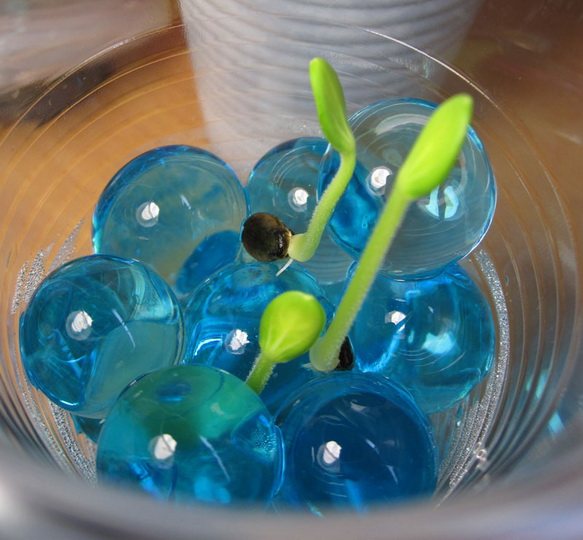

If the flower is already planted in the soil
It is possible to add hydrogel to peas with already planted flowers. With a stick, you need to carefully make depressions in the soil, reaching the roots. Pour dry granules into them and pour over. After being saturated with water, the gel will increase in size and can be displaced on the surface. The excess must be removed, and the holes must be sprinkled with soil.
Applying a hydrogel to flowers without adding soil
Some plants can be grown directly in hydrobeads. Here's how to use a non-earth flower hydrogel:
- for irrigation, you should take settled water with nutritious dressings;
- the pot should not be in direct sunlight, otherwise plaque and mold will appear;
- add distilled water as needed, so as not to develop harmful microorganisms.
Hydrogel to protect the exposed root system during planting, transplanting and transportation
In the garden, the gel is used for rooting cuttings: the container is filled with a swollen hydrogel and the sprout is placed in the middle. When planting seedlings in the ground, the moistened granules are mixed with the ground in a ratio of 1: 5. In addition to moistening, they will provide air access to the root system, as the soil will become looser. You can make holes around the transplanted young trees and cover with dry matter, sprinkling with soil on top.
If you pour a solution with fertilizer, then the tree will receive additional nutrition for a long time.
How to apply the gel under already planted trees, bushes, other crops?
You can add hydrogranules under the planted crops as follows:
- In the area of the trunk circle of a tree or bush, make punctures 20 cm deep. Pour dry gel into holes and cover with earth. Water abundantly twice at hourly intervals.
- Embed the soaked granules into the soil surface along the perimeter of the plant. It is better to do this manually so as not to damage the roots.
How gardeners use hydrogel
In the garden, this substance is used no less often, so it is worth figuring out how to use the hydrogel for plants correctly.
In this substance, it is very convenient to germinate seeds (which do not have a hard shell) and to grow seedlings until the very moment of their transplantation into open ground. In addition, part of the hydrogel can also be dug into the beds, so that it retains moisture near the plant roots longer.But tomato seedlings can remain in the hydrogel until the very beginning of flowering (it is only important not to forget about additional fertilizing), which will allow you to get a good harvest and forget about many diseases of this plant, which bushes can become infected through the soil.
However, the use of a hydrogel for vegetables when grown outdoors can play a cruel joke with the gardener. Hoping that the hydrogel will provide the plants with enough moisture, the gardener may skip a few waterings, causing the vegetables to wilt badly. Therefore, it is necessary to be extremely careful to adapt to the hydrogel and its capabilities, especially since if there is a hydrogel in the soil, it will be safer to fill the plants with water than to leave them dry.
In general, it is worth using a hydrogel in gardening only when growing:
VnThe hydrogel granules should be sown to a depth of about 5 cm.
If the soil is light, then 1 sq. m, no more than 10-20 g of dry matter is required, if heavy (loam) - from 20 to 30 g for the same area.
What Wikipedia writes about the hydrogel
So, it turned out that the all-knowing Wikipedia gives concepts like "Gel" and "Silica gel". So, silica gel is a dried gel. If I understand correctly, then it is not entirely correct to call balls hydrogel. You can also hear aqua soil from florists, and water balls from mothers - as they are called in the common people.
The ability of silica gel to absorb a significant amount of water is used for drying various liquids, especially when the liquid to be dehydrated dissolves water poorly. Silica gels also serve as desiccants in the preservation of equipment to protect it from corrosion.
Along with water, silica gels absorb vapors of many organic substances well. This property is used to capture vapors of gasoline, benzene, ether, acetone, etc. from air, benzene, from gas coke ovens and gasoline from natural gases.
Source of information about the hydrogel Wikipedia
Hydrogel for plants: pros and cons of using
There are, of course, more advantages in using a hydrogel when growing plants.
Among them - the ability to retain moisture and protect the roots of flowers from its excess, deliver nutrients to the roots, and also make flower pots more attractive. However, it is not recommended to use hydrogel alone for growing plants. In any case, nutrients should be added to it, and although watering will cease to be regular, it will still be needed.
Another disadvantage of the hydrogel is the ability to bloom when the pots are kept in open sunlight. In addition, one and the same hydrogel can be used only for one plant, since when other species are planted, its sterility property will be lost.
The question remains very relevant as to whether the hydrogel is harmful.
This substance has no danger, since it itself does not evaporate, and when decomposed, the hydrogel turns into what it consists of - water, carbon dioxide and ammonium, which is harmless to plants. Thus, we can conclude that the composition of the hydrogel is completely harmless, although it must be applied only taking into account all the above rules and features. Hydrogel -
very useful in floriculture and horticulture, a substance that can save summer residents from the need to water the plants every day.
We hope that after our article you will no longer have questions about what the hydrogel is made of and how dangerous the hydrogel is when using it.
Read also: The main diseases of goslings and their treatment
Types and chemical composition of the hydrogel
The hydrogel consists of granules, packaged in sealed bags. Fine material is used for germinating seeds, larger ones are added to the ground. Color and caliber have no effect on properties. On sale you can find several types of gel for plants:
- Balls that soften on contact with liquid. They do not damage plant roots, reduce the frequency of watering, and are optimal for germination and rooting of cuttings.
- Coarse colored fractions of various shapes. Designed for decoration.
- Completely soluble in water. They are used for seed treatment before sowing.
The use of a hydrogel for plants is safe, since the material is a sterile polymer that decomposes into water, carbon dioxide and ammonium.
A valuable property of this substance is the ability to absorb moisture as much as possible and gradually release it into the environment. So, 1 g of dry hydrogranules can absorb up to 300 ml of liquid.
What is a hydrogel like?
Let's dot the "i" right away. On the market of goods for the garden and vegetable garden, you can often find the so-called aqua soil, sold in the form of multi-colored granules, which, when swollen, turn into bright transparent balls. Sellers often call it a hydrogel, thereby attributing the beneficial properties of a "garden assistant" to aqua soil and misleading gullible buyers.
Aqua primer has only decorative qualities. It cannot be used to grow plants, but you can create compositions, for example, by placing colorful balls in a vase of fresh flowers instead of water.
The "correct" granular hydrogel in dry form is a fine white crumb. Hard grains have different shapes, and after they absorb moisture, they increase 200-300 times and transform into a granular jelly-like mass. Such a hydrogel is used as a substrate or is introduced into the soil: plant roots penetrate into the gel "reservoir" and take as much moisture as necessary. At the same time, the water in the gel does not stagnate or evaporate.
Liquid hydrogel is not used very often in our area. Before "cooking" it looks the same as a regular hydrogel, but after adding water it does not swell, but dissolves in it. In a liquid hydrogel, seeds are moistened before sowing to accelerate the germination of seedlings. But it is not worth germinating seeds in it: the liquid hydrogel envelops the seed, making it difficult for oxygen to access.
For which crops is it suitable?
The use of a hydrogel is possible when growing all moisture-loving plants. The polymer will create comfortable conditions for indoor flowers: chlorophytum, euphorbia, ivy, Kalanchoe, fat woman. Many inhabitants of the garden and garden will delight you with active growth and flowering while maintaining optimal soil moisture with gel balls. It is not recommended to use hydrogranules for cacti, orchids and aroid class.
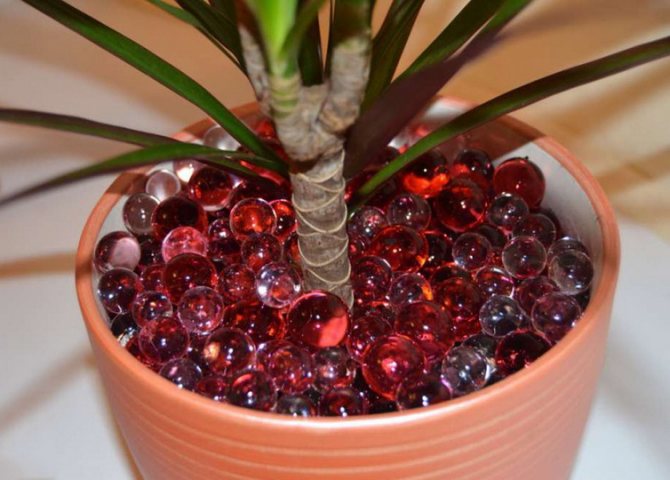

Pros and cons of hydrogel
Like everything else in the world, the hydrogel has its advantages and disadvantages. Let's start with the pros:
- germination accelerates, seedlings grow 1-2 weeks faster than when grown in soil without a hydrogel, and the yield increases;
- if the granules are soaked in liquid fertilizer, the plants will receive long-term beneficial nutrition;
- the soil with an admixture of hydrogel retains a loose structure, which means that the roots of plants in it, as they say, breathe easily and freely;
- in the open ground (when the hydrogel is introduced into the soil), the survival rate of seedlings is 95-98%, and the sown lawn retains its decorative effect throughout the season;
- economic benefit: only 0.8-1.6 g of dry matter is consumed per 1 liter of soil.
And now - about the cons of granular hydrogel:
- seeds with a hard leathery shell cannot be germinated in it: sweet peas, beans, beans;
- with prolonged exposure to sunlight, mold may appear on the hydrogel;
- you can grow a plant in a pure hydrogel for no more than 2 years, after which it must be replaced.
As you can see, this miracle gel has much more advantages than disadvantages, so why not try it out in practice?
Gardening calendar using hydrogel for central Russia
| Types of jobs | Period |
| Sowing seeds for seedlings | February to May |
| Planting in the ground, replanting seedlings and seedlings | April to June |
| Additive to soil for planted garden crops | April to October |
| Autumn replanting of bushes and trees | August to mid-October |
| Laying a young strawberry plantation | July to September |
How to use a hydrogel?
There are several uses for hydrogel in plant cultivation:
Germinating seeds
Grind the wet hydrogel until smooth and spread in a 3 cm layer on the bottom of a transparent container. Press the seeds lightly into the gel mass and cover the container with plastic wrap. Lift the condensation film daily.
When using the hydrogel, make sure that the granules do not spill onto the floor or garden path, otherwise there will be a risk of slipping on the swollen gel.
Growing seedlings
Add 1 part of dry hydrogel granules to 4 parts of soil and pour the soil mixture into the seedling container, not adding 0.5-1 cm to the edge. Then sow the seeds on the seedlings as usual, sprinkle with water.
If you wish, you can sow the seeds directly into the finished hydrogel, but in this case, in the cotyledonous leaf phase, you will have to transplant the seedlings into the soil mixture. Do this carefully, without removing the granules from the spine.
What is a plant hydrogel and how does it work?
According to the chemical formula, hydrogel refers to polymers (cross-linked copolymers) capable of retaining large amounts of water and fertilizer solutions. The absorbency of the hydrogel is such that 1 g of dry matter can absorb 0.2-0.3 liters of water.
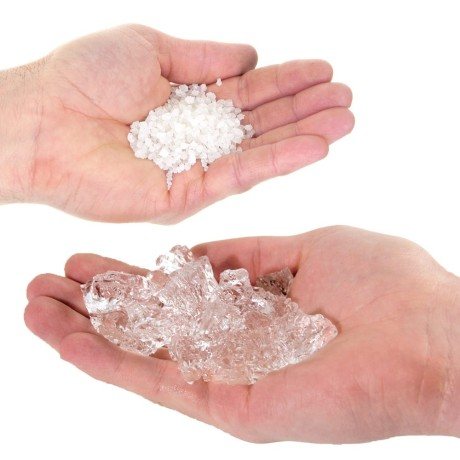

Dry hydrogel and saturated with water - 200-300 times magnification!
In order for the hydrogel to start working, it must be introduced into the soil in the access zone of the plant's root system. Most often - in an already swollen, saturated state with water, less often - in a dry state (then abundant watering is required immediately after application).
After 2-3 weeks, the roots of the plant will germinate through the hydrogel capsules and will be able to absorb moisture from there without waiting for the next watering. The soil between waterings may dry out completely, but this will no longer be a shock to the root system. The hydrogel will act as a back-up source of water to keep the plant from withering and drying out during dry periods.
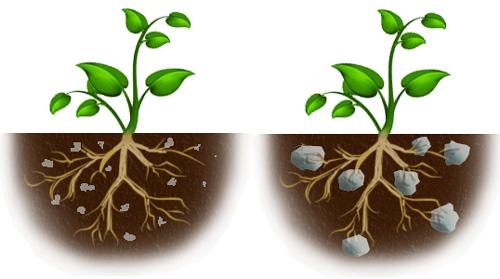

The roots of the plant grow into the hydrogel and begin to feed on water from there.
Hydrogel granules can be saturated not only with water, but also with fertilizer solutions. Then, in your absence, the flowers will not only not fade, but will continue to eat "right".
Due to the ability to adsorb moisture, the hydrogel has another property: it will not allow the flowers to flood. Any excess moisture that would normally drain through the drainage holes is absorbed into the hydrogel and then absorbed by the plant as needed.
I would like to note right away that this article is not about the Chinese hydrogel or, as it is also called, "aqua soil". These are slightly different materials, although they have a similar polymer nature. The purpose of the agrarian hydrogel is to serve as a source of additional water for plants. The main purpose of the aqua soil is a decorative effect.
History of creation
To the invention of a hydrogel for plants, scientists were prompted by the idea of obtaining a crop in any part of the Earth, in any conditions. The increase in population after World War II put them at risk of food shortages. To feed people, it was necessary to increase yields by reclaiming previously unusable plots of land.
The UN has given the task of leading chemical concerns around the world to begin work on the invention of a hydrogel. It was with the help of it that it was planned to increase the yield without having a negative impact on nature. The first samples of the product were created in the countries of Europe and America. They solved the problem of not only moistening, but also fertilizing the soil - the gel contained a potassium compound in the composition.This combination helped to increase yields by 30-60%.
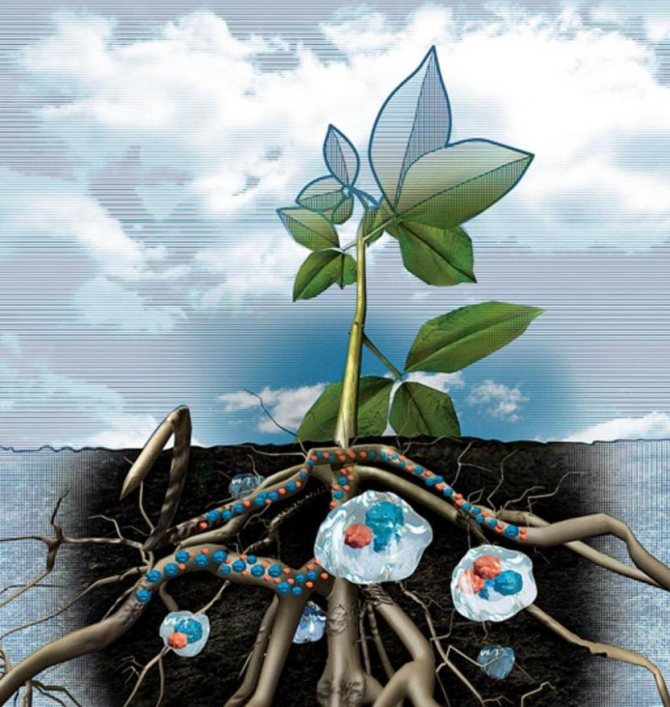

Today aqua primer (hydrogel) is still used in agriculture. A special advantage is the freezing of capsules, which does not diminish the useful qualities of the product: after thawing, the particles are found in their original state. Well, lovers of indoor flowers use the gel for their plantings.
The best way to use it is to mix the capsules into the soil once every five years. During this period, the gel will absorb the liquid and supply it to the plant. And then the polymer will decompose into carbon dioxide, ammonium and water. So there is no harmful effect on the soil and the environment.
Application nuances
The hydrogel can be used for gardening and growing indoor plants, both dry and wet. Only swollen crystals are poured into flowerpots, because the balls can lift the soil. In open ground, you can add both the dry fraction and moist crystals. When applied to a garden bed, the soil is additionally watered with water or a mixture with fertilizers. The hydrogel will gradually release all the moisture and nutrients to the plants.
In addition, the polymer is applied under already grown bushes and trees. If the hydrogel was not introduced in a timely manner, then depressions with a depth of 30 to 40 centimeters are made near the bushes and 20 to 40 grams of dry granules are poured into the pits. The amount of the substance is calculated depending on the age of the plant. Fertilizers and soil are poured into the pits from above.
Popular: Correct spring planting of siderates in the greenhouse and in the ground
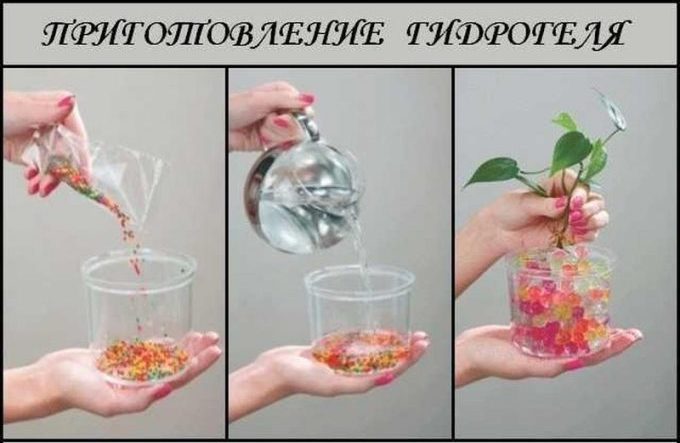

In the same way, crystals can be applied to beds with perennials and shrubs. In this case, the amount of the hydrogel is from three to ten grams. The pits are made no deeper than 30 centimeters. After applying the product, the gardener should water the soil with water in two doses with an interval of 60 minutes. You do not have to make additional pits, but just gently deepen the hydrogel near the plant, mixing it with the soil.
Dry crystals for indoor plants can be used in the same way. To do this, punctures are made in the pots in the soil. After the flower has been watered, part of the gel can be squeezed out of the soil, the balls are additionally sprinkled with soil.
Crystals for storage, transportation of plants
Crystals can be used to protect the root system during transport or if the plant needs to be stored for a long time. For storage purposes, you should buy a special hydrogel in the form of a powder. When the crystals are mixed with water, they become jelly-like. Plant roots are dipped in this solution. The resulting film prevents the root system from drying out. The effect lasts two to three days.
What is the difference between aqua primer and hydrogel
Some manufacturers, seeing the popularity of the hydrogel, began to make another product, trying to sell it as a gel. Aqua soil is not mixed with the ground, because it can injure the roots of flowers and plants. Manufacturers advertise that it is used to grow seedlings and seeds. People, without understanding, pour it into the ground and harm their plants. For this reason, buyers leave a lot of negative reviews about the hydrogel, because they expect a completely different result.
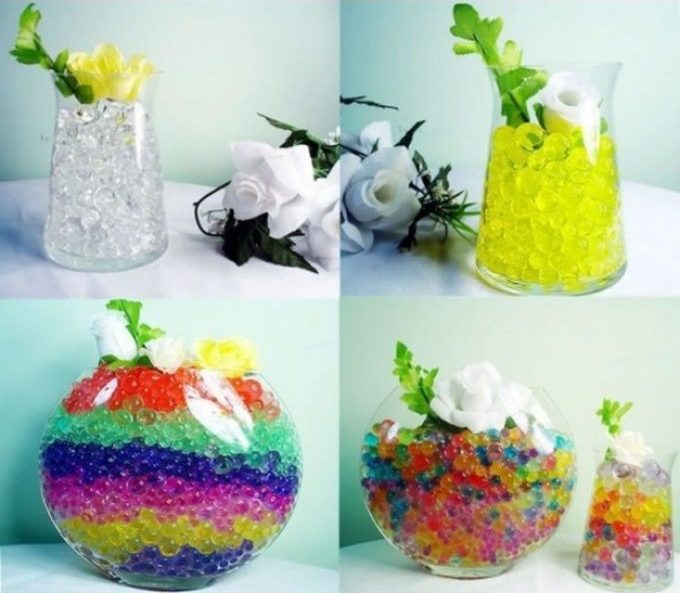

Another subtlety is the types of plants for which the substances are used. If polymers are ideal for one color, then the second, on the contrary, negatively perceive such innovations. Therefore, gardeners recommend using both varieties with the ground.
Hydrogel and gardening
How can a hydrogel help in gardening? It is very useful to use it for the development and rooting of petioles or for propagation of bushes by layering. You can mix it with soil at a rate of 1: 5 for transferring seedlings to open ground, which is not always suitable for everyone. A hydrogel can help make the soil more fertilized, especially if the plant needs nutrients.Also, gel balls are used to loosen heavy soils, this facilitates the penetration of more oxygen.
Water balls are very useful in spring when snow melts. They are placed dry in the ground. Then the same balls can be dug into the soil around the young seedlings.
Hydroballs are added even to the near-stem areas of the soil of already mature fruit-bearing trees.
Is it possible to make a hydrogel with your own hands
Many people have a question whether it is possible to make a hydrogel for plants with their own hands. Naturally, we are not talking about an industrial scale. Naturally, it is more profitable and easier to buy a real hydrogel. But with an urgent need for a small amount of hydrogel and the impossibility of immediately satisfying it, the hydrogel can be made from a diaper. To do this, you need to cut the diaper and remove the granules from it, which are saturated with water. But it should be borne in mind that a new diaper is more expensive than a special hydrogel, and a hydrogel from a used diaper contains salts that significantly reduce its ability to reabsorb moisture.
Uses, harms and benefits of hydrogel for flowers and people
Of course, the real purpose of Orbiz is very different from how children use it. In fact, the hydrogel is used to provide water to plants. Let's take a look at how this wonderful remedy works:
- Pour a certain amount of hydrogel with water
- Wait 4-6 hours until the hydrogel increases in size
- Pour the hydrogel into the pot to the plant
Just three simple steps that make life a lot easier and help save energy. Having heard so many useful properties of Orbiz, the thought arises of its incredible value. Useful, easy to use, which means for sure expensive, and it is sold somewhere in special stores. But no, everything is much simpler. The hydrogel can be found in almost any kiosk or small shop of household goods, and a bag with 1000 balls costs about 100-150 rubles. Agree, a ridiculous price for such convenience.
Hydrogel balls can save you from watering your plants for exactly one month. One pack is enough for so much, and you need to change the balls every two weeks. That is, it turns out that instead of collecting water every day, watering the flowers and spending some of your time on it, which may not be so much, it is enough to pour Orbiza into a pot just once every two weeks. Thus, the owner of indoor plants saves not only time, but also water, which also costs money, energy that is expended every day, and if you have a semblance of a home garden at home, this is how much effort is needed to water it all.
However, is everything so smooth and easy? What if the plants don't appreciate these wonderful properties of the hydrogel? Maybe the hydrogel will harm them, and the indoor flowers will die? The composition of this aqua soil looks scary and incomprehensible: a spatially crosslinked gel of polyacrylamide and potassium polyacrylate. On the packaging itself with orbis, they write that the gel is absolutely harmless to plants and humans, but this is not entirely true. The hydrogel balls contain a substance that is toxic to humans - acrylamide, which can enter the body in the form of dust if inhaled. This toxin can cause cancer in some animals.
But in reality, things are not so bad. Acrylamide is released after prolonged use of the hydrogel, it can be safely used for a year, then it is better to throw it away so as not to harm yourself and your pets.
Growing seedlings
The flower hydrogel can be used to grow beautiful seedlings. In the process of planting development, all the necessary nutrients are obtained. This is especially important when growing young specimens.
To obtain high-quality seedlings, gardeners overcome a lot of difficulties. In order for the seedlings to grow healthy and strong, it is necessary to organize them with good lighting, appropriate soil and proper watering.Young seedlings need moisture, but its excess is destructive and leads to decay of the root structure.
To prevent such troubles, a hydrogel has been created. The product has unique qualities: it is able to absorb moisture and retain it, providing favorable conditions for the growth of planted plants. The hydrogel minimizes the maintenance of flowers and also reduces the stress caused by transplanting.
Aqua soil size
When dry, the polymer has a bead-like appearance. It can be of various shapes, but most often it is round, because, unlike cubes and pyramids, it looks more attractive both when used in decorative floriculture and for other purposes. The balls come in different sizes, which will influence the final result. They can be small or gigantic. Small balls include elements of the following sizes:
- 2-2.5 mm, increasing up to 1.5 cm;
- 2.5-3 mm, growing up to 1.8 cm;
- 3.5-4 mm, reaching 2.5 cm.
The secret of "extending the life" of aqua soil
One of the disadvantages of polymer solid soil is the loss of attractiveness, the possibility of mold formation before the end of its service life. Of course, the cost of aqua soil is not high, but no one wants to injure plants by frequent transplanting or burden themselves with constant replacement of old balls with new ones. Therefore, it is better to secure yourself in advance, knowing how to preserve the color and avoid "blooming" of the polymer.
The chemical structure of aqua soil is sensitive to water quality. It should not be dirty, too chlorinated or harsh. If the water from the tap is not of the highest quality, then it is better to use filtered water. The temperature regime deserves no less attention. Water should be taken at room temperature or cool, but not too warm.
These water requirements apply not only to the first planting, but also to further watering.
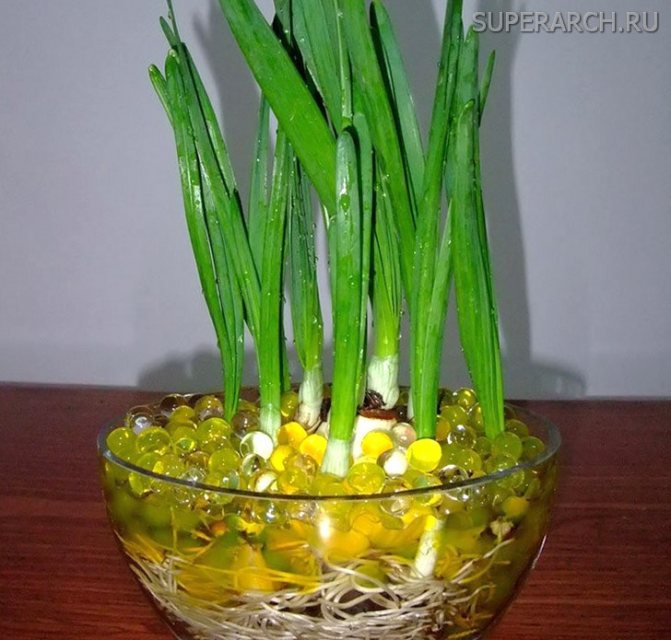

How does an aqua primer differ from a hydrogel?
These two materials have similar appearance and properties, but have significant differences. Aqua primer is a decorative type of hydrogel, which is a unique water-absorbing polymer. One gram is enough to absorb at least two hundred milliliters. Studies have shown that the substance is absolutely safe and belongs to the group of non-toxic biodegradable. The crystals of this polymer are small in size, increase in volume under the influence of moisture, and can improve the qualitative composition of the soil. Taking water during irrigation or during rain, the hydrogel subsequently releases it when the soil dries up. Thus, the root system receives the required amount of moisture during the period of "drought", which protects the plants from death. The chemical structure of aqua soil is similar to that of a hydrogel, but it is intentionally produced with a denser structure. A decorative dense variety of eco-soil is produced in granules, which can be in the form of balls, cubes, pyramids, painted in one or more shades.
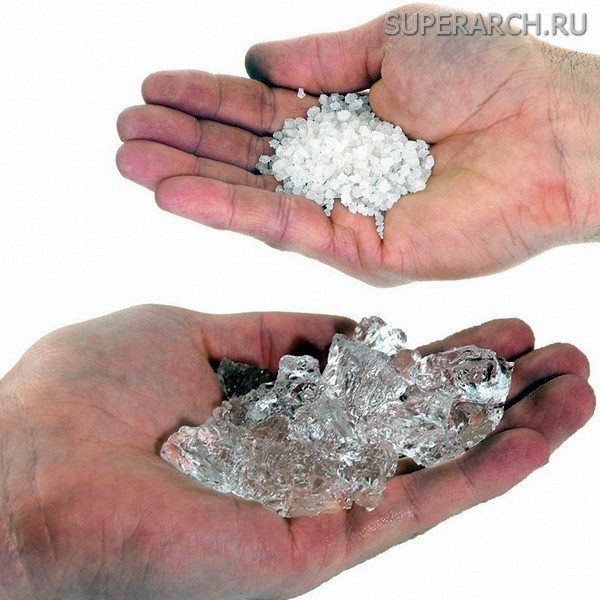

Disadvantages of aqua soil
Like any material, aqua soil has not only positive qualities, but also disadvantages:
- Short service life. The plant can be in the polymer from one to two years.
- Lack of drainage holes. The bottom of the container must remain intact. The root system breathes due to the presence of air between the granules. This is not enough for all plant species.
- Loss of attraction. The polymer does not have reliable moisture protection. It can become moldy or bloom. This is most often the main reason for replacing aqua soil.
The decorative polymer cannot be considered a full-fledged substrate. It lacks nutrients. Consequently, its use does not relieve the grower of the need for regular application of various complexes of organic and mineral fertilizers.A similar phenomenon is typical for any type of soil, including finished shaped. There is no substance that does not require periodic feeding. Therefore, to call this point a significant "disadvantage" would be an exaggeration.
Additional caveats
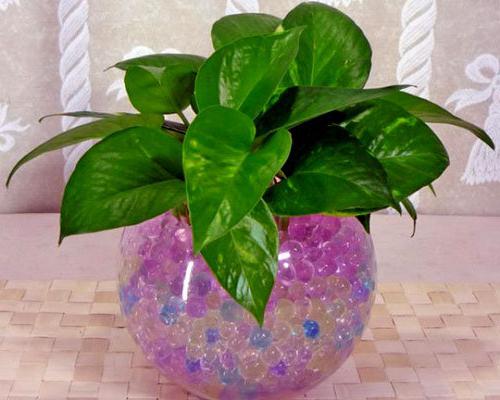

Manufacturers assure that the hydrogel for plants is absolutely harmless. Many parents buy it not even for flowers, but as a toy for their child. Consider whether it is worth doing: the polymer contains acrylamide, which is considered a neurotoxin. In addition, the experimental animals, according to some reports, developed cancer from acrylamide. It really does not harm plants (at least, mixed with soil). But the child may well get by with other toys.
If you nevertheless decide to plant at least the same bamboo in an elegant colored hydrogel for plants, choose a place where the sun is not too bright. Firstly, the balls fade rather quickly from its rays. And secondly, in their presence, the water begins to turn green rather quickly and acquires a pungent unpleasant odor.
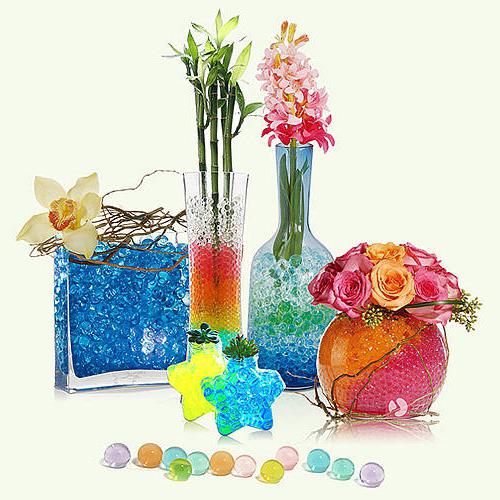

Privacy Policy
General Provisions
Some of the objects on the site are intellectual property. The use of such objects is established by the current legislation of the Russian Federation.
On the website "Internet-shop Hydrogel33" there are links that allow you to go to other sites. is not responsible for the information published on these sites and provides links to them only for the purpose of providing convenience for visitors to its site.
Personal information and security
Our company guarantees that no information received from you will ever and under any circumstances be provided to third parties, with the exception of cases provided for by the current legislation of the Russian Federation.
In certain circumstances, it may ask you to register and provide personal information. The information provided is used solely for business purposes, as well as to provide access to special information.
Personal information can be changed, updated or deleted at any time under Account> Profile.
In order to provide you with information of a certain kind, with your explicit consent, it may send information messages to the e-mail address specified during registration. At any time you can change the subject of such mailing or unsubscribe from it.
Like many other sites, "Hydrogel33 Online Store" uses cookie technology, which can be used to promote our product and measure the effectiveness of advertising. In addition, with the help of this technology, the "Hydrogel33 Internet store" is configured to work with you personally. In particular, without this technology, it is impossible to work with authorization in the control panel.
The information on this site is for informational purposes only, and any changes may be made to it without any prior notice.
To refuse further communications with our company, change or delete your personal information, write to us through the feedback form
Growing indoor plants in a hydrogel - the latest technology
The hydrogel will also help plants growing on the windowsill. If you are planting in a new pot, the presoaked polymer is added to the potting mix. Moisten it well (1 g per liter of soil) and let it absorb water. You can soak it overnight.
During planting, mix the prepared granules with the soil mixture, then plant the plant according to the general rules. After planting the seedling, water it, the roots have not yet adapted to the new place, but they need nutrients. You can only feed with water-soluble compounds and not as often as plants in ordinary soil.
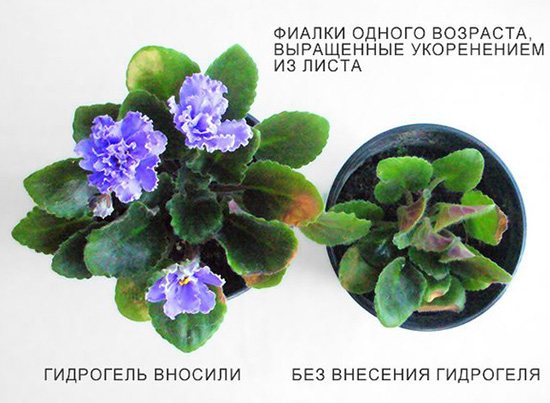

If you need to add polymer to a pot with a growing indoor plant, then you must first calculate its volume. For 1 liter, you need to add 1 g of dry granules, this is about ¼ teaspoon. Puncture the soil to the bottom of the pot and add the hydrogel to it.
Then the plant needs to be watered, if some granules appear on the surface - they need to be sprinkled with soil 1-2 cm thick, after a short time the roots will reach these granules. And the lack of moisture for 15-20 days will not harm them, so if you go on vacation, you will not have to worry about your pets.
Varieties of hydrogel
First you need to figure out what a hydrogel is. It is a substance obtained from polymer components capable of absorbing liquid while increasing in size.
- maintains moisture balance;
- retains nutrients in the soil longer, allowing seedlings to better absorb them;
- loosens the soil and structures it;
- accelerates the development of plants;
- protects the soil from cracking and drying out.
- Plants growing in a pure hydrogel are best placed in shaded areas, since under the rays of the sun the water blooms and emits an unpleasant odor;
- colored granules quickly lose color, and in bright light they lose their decorative effect;
- the granules on the surface dry quickly. At the bottom of the container without air, they become moldy.
They produce 2 types of this substance, which differ in their characteristics and methods of use:
- Hydrogel - soft, uncolored polymer used as a leavening agent and to moisturize plant roots. This is a material with a jelly-like structure, root hairs of plants, penetrating into granules, absorb nutrients and water;
- Pour the contents of the package with 500 ml of water;
- Wash the soil from the roots of the transplanted plant;
- Put polymer balls in a container for a plant, if you want to create a multi-colored composition, it is a good idea to use a transparent vase for a seedling;
- The used hydrogel, after drying, takes on its original form, it can be saved until the next use or re-fill with water and plant a plant or put cut flowers.
After 12 hours, the composition will absorb the required amount of liquid and will be ready for use (you can add the necessary fertilizers to the water in advance), each particle will increase to 1.5 cm;
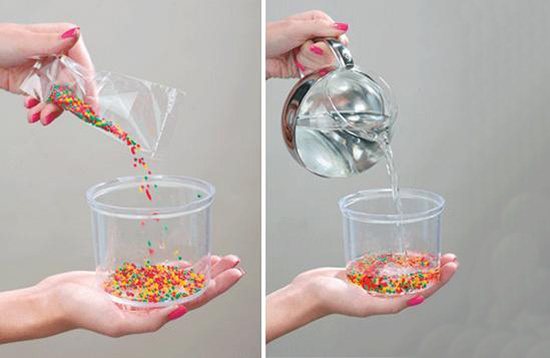

The substance is economical, 1 small sachet is enough to obtain 500 g of soil, which is enough for a narrow vase or pot.
If the upper part of the gel dries up, then it is necessary to remove the dried granules and soak them in water for 1 hour. By adding hydrogel to the soil mixture, you create a strategic supply of nutrients and moisture for the roots. At the same time, you can reduce the amount of watering, and the fertilizing compounds will not burn the plant roots.
The use of a hydrogel at a summer cottage
The hydrogel is added soaked and dry for any culture. Polymer granules will help solve the problem of high groundwater levels in your area, it will remove water from the roots. The component, previously soaked in a fertilizer solution, will immediately deliver nutrients to the plant roots.
A hydrogel is added under adult trees, taking into account the strength of fruiting and age (within 20-40 g). By the size of the crown around the trunk, they pierce the soil 50 cm with a sharp object, and the hydrogel is poured into these punctures. It is also added under shrubs of 3-10 grams to a depth of no more than 30 cm.
Price
You can buy gel balls at garden malls, flower sales departments, or order delivery by mail in an online store. The cost depends on the packaging of the substance. An overview of prices in Moscow and St. Petersburg is presented in the following table:
| Brand name | Packing, kg | Cost, rubles |
| "Aquasin" | 0,1 | 230 |
| "Aquasin" | 1 | 700 |
| "Aquasin" | 10 | 6500 |
| "Happy Summer Resident" | 0,1 | 133 |
| "Happy Summer Resident" | 1 | 1169 |
| "Dunamis" | 0,1 | 107 |
| Zeba | 0,02 | 80 |
| Zeba | 0,1 | 339 |
As for the seeds
Some instructions describe how convenient a hydrogel for plants is for germinating seed material - its use seems to guarantee one hundred percent germination. However, from the point of view of botany, this is absurd. The invention is intended for penetration into the capsules of the roots, which must extract liquid from them. The seeds have no roots, so they have nothing to "suck" the water with. Therefore, do not spend money on a hydrogel for plants - its price, of course, is not high (about 37 rubles per bag, wholesale - 800 per kilogram), but for this purpose it is absolutely useless. Traditional wet gauze is much more effective.
How to use a hydrogel?
If you decide to use it to increase the effectiveness of watering, then the method is extremely simple: a hydrogel for plants is mixed into the soil intended for planting. The instruction recommends not to soak it and take it in the amount of 10-20% of the mass of the earth. After planting at the right time, water the flower, and the gel immediately begins to "work".
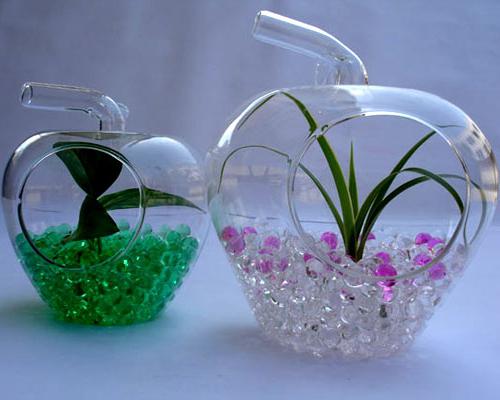

If you decide to take a chance and plant the plant in aqua soil, then its balls are soaked in water with diluted fertilizer for half a day. A separate vessel is taken for each shade of granules. The hydrogel is poured into a glass (not crystal! Crystal contains lead oxides) vase, as artistically as possible, the roots of the plant are carefully washed from the ground, and it is placed in a bowl. In this case, you need to choose a flower that is not high, since the hydrogel does not differ in the reliability of retention. And choose those plants that need a little light and more water.
What plants are suitable for
It is worth distinguishing between aqua soil and hydrogel - these two products have different effects on the root system.
Aqua primer is used for decorative purposes, you can put a cut flower in it to prolong its decorative properties.
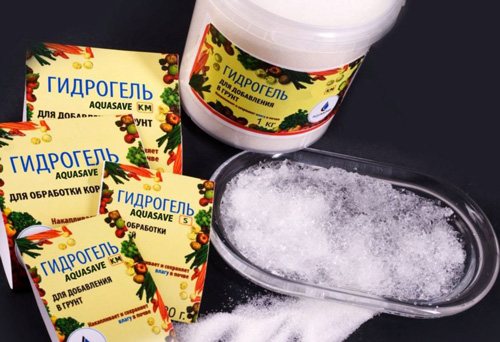

Consider which plants are suitable for hydrogel in powder and balls:
- Spurge.
- Money Tree.
- Dieffenbachia.
- Asparagus.
- Ivy.
- Tradescantia.
- Kalanchoe.
- Chlorophytum.
For 1 kg of hydrogel, the amount of water indicated on the package will be required.
At the same time, do not forget about caring for the plantings: they are not recommended to be placed in direct sunlight, this will contribute to the growth of mold.
Useful video
How to play
Check the temperature of the water, whether it will not be cold for the hands of the child.
- The balls can be removed from the bowl by hand. They are quite slippery and resilient, easily slip out of the child's hands. Therefore, he has to put in some effort. This arouses the interest of the baby, because the balls become as if they were alive. They often fall out of hand and jump on the floor. Collecting them, he also develops fingers, learns to coordinate movements, develops fine motor skills of the hands.
- You can remove the granules with a plastic spoon or strainer. The second method is better in that the balls are removed without water. Spread out on the surface, examine. You can put them in a plastic bottle right away. This activity develops dexterity and coordination.
- You can play with balls without taking them out of the water. The child goes through the granules, pours from one hand to the other.
- Multi-colored balloon sets will help you explore the colors. For this, balls of different colors are placed in separate bottles.
- Place small toys in a bowl with granules, mix. A child with closed eyes tries to find them among the granules and guess their name.
- If children start counting, hydrogel beads can be used to develop these skills. The child takes out the balls and counts them.
- There are special kits in which balls are attached to a set of dyes. They stain water with it, pour out the balls and observe how the color of the granules changes.
Adding polymer to the beds
For gardening, from 2.5 to 10 kilograms of dry substrate should be applied for each hundred square meters. More hydrogel is poured into the light, loose soil.Less substance is applied to a loamy or chernozem garden. The fraction is mixed with soil to evenly distribute the product, then it is covered with earth from above. The hydrogel should not be on the surface of the soil (garden bed), because sunlight is harmful to it. After the soil has mixed, the entire area is additionally watered.
You can also pour the balls into the holes prepared in the garden bed. Before this, the hydrogel for plants is additionally soaked in water. Swollen balls are placed at the bottom of the recesses in an approximate proportion of one to five. After that, the earth in the hole is mixed. Then you need to plant the plant, sprinkle it to the desired height with prepared mixed soil so that the hydrogel is lower than five centimeters from the surface of the garden.
Typical mistakes when using
The main mistake in using a polymer compound is frequent watering. You cannot focus on the visible soil layer, even if the surface is dry, inside it can remain wet for a long time. To check, you can stick a thin twig deep into the ground, twist it several times and remove it: if there are traces of contamination on the wood, then watering is not required yet. In order not to harm the care, you should adhere to a number of rules:
- Make purchases only in specialized stores and professional websites. By purchasing a cheap fake, it will be difficult to achieve the desired result.
- The drug should be used in the correct dosage. For one hundred square meters of land, 100 grams of hydrogel is required, and you need to add it annually.
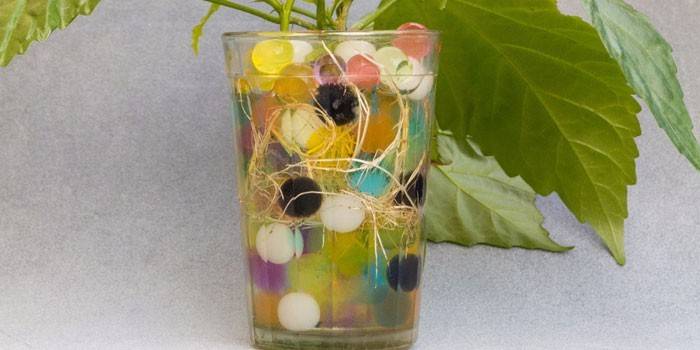

Correct sowing of plant seeds in a hydrogel
Polymer capsules can be successfully used in seed germination. This method is not shared by the manufacturers of the product, but gardeners are actively using it.
First, you need to soak the hydrogel, drain the excess liquid, and grind the remaining mass through a sieve or grind in a blender. You get something like a homogeneous "jelly", which is evenly distributed over the bottom of a shallow and wide vessel. The hydrogel layer should be 1-2 cm.
Seeds are laid out on it, which must be pressed down using a toothpick or a match. After planting all the seeds, the container should be covered with foil and wait for them to sprout. After seed germination, when the first leaves appear, sprouts and pieces of hydrogel are transferred to the soil.
Product Description
Few know what a hydrogel is, despite the fact that it is gaining more and more popularity. Gel beads are a common polymer that has been crushed into powders or granules of various shapes.
The peculiarity of hydroballs is their ability to absorb significant volumes of liquid, which later simply evaporates or is absorbed by the rhizome of the plant. Thanks to this ability, even the smallest balls can swell to very large sizes.
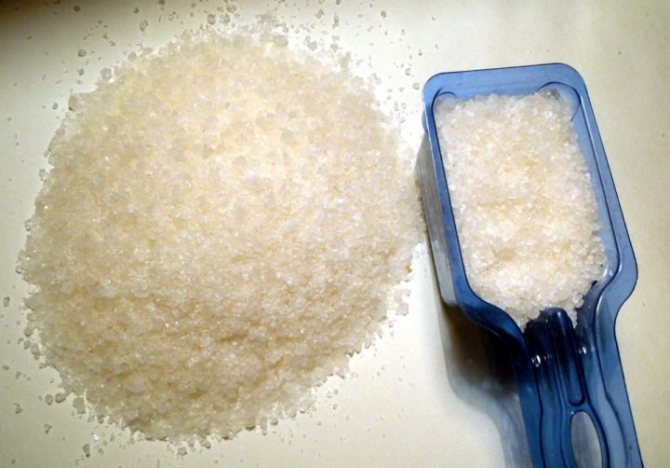

Hydrogel in crystals
1 g of hydrogel granules can absorb about 200 ml of water. Therefore, to remove about 3 liters of liquid, you will need only 2 tbsp. l. balls.
A hydrogel is a sterile substance. In it, pathogenic microflora is unable to start. The material gives off moisture gradually and slowly, so you don't have to worry about the possible rotting of the plant rhizomes.
The balls do not contain any useful ingredients.
Who needs Orbiz and where is it used
We figured out how to use Orbiz and realized that it is incredibly useful in crop production. But is it worth now to take money and globally purchase hydrogel? Obviously, there is no great need for this, but the hydrogel is used by many people in different professions.
The very first profession that comes to mind is, of course, a gardener. Of course, caring for a large garden or flower bed requires a lot of effort and precious time, we can say that a gardener is a way of life.Watering plants every day is very tiring, so you have to somehow get out of such a routine so as not to torment your body. Of course, if some of the plants draw moisture from the hydrogel, then the time spent on watering will be reduced significantly.
But the gardener is far from the only profession that interacts with the hydrogel in one way or another.
teaches strange and surprising, but designers also actively use Orbiz. It turns out that the creators need it in order to grow the figures they need from the moss. Whole "moss graffiti" are created based on the hydrogel. And of course, multi-colored hydrogel balls will look very beautiful and original in transparent pots. You can put very little soil on the bottom, and fill the rest of it with Orbiz. This will help brighten up a dull and gray look in the office, or add additional colors to the interior of the house.
Also, the hydrogel is very actively used by scientists to conduct experiments on plants and flowers. The experiment can last quite a long time, because it can include monitoring the growth of the plant, but this is still a long process. In order not to waste extra time caring for the plant, the experimenters simply put it in a container filled with hydrogel, without even adding soil. Thus, it turns out to allocate more time for the main part of the experience and concentrate on it.
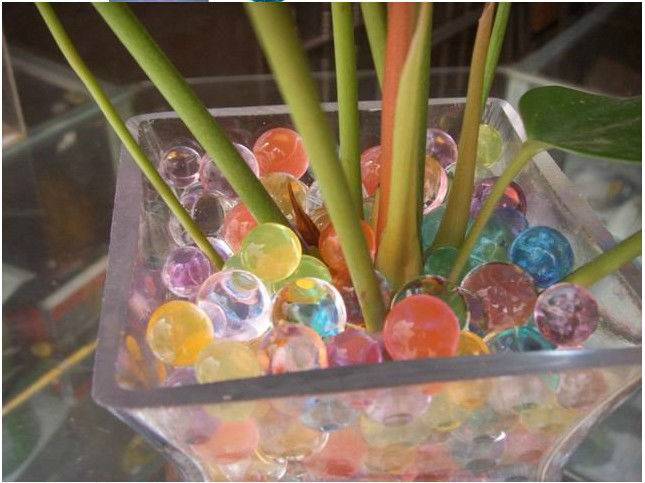

About the pros and cons of hydrogel
Having analyzed and clarified the main points and information about the hydrogel, let's make a complete list of the advantages and disadvantages, and then we will conclude whether it is worth using the hydrogel or not.
Pros:
- Easy to use
- Sold almost everywhere
- Looks good
- Saves energy, time and money
- Low price
- Suitable for experimentation
Minuses:
- Harmful to health after prolonged use
- Many substandard fakes
- Some plants do not take root
After doing a little analysis, we can see that there are two times more pluses than minuses, which means that Orbiz is a really good thing. However, there is one drawback that stands out from the others and is more important - harm to health. After all, even if you list ten, one hundred pluses, health will still remain the most important criterion for assessment. But it is enough just to limit the period of use of the hydrogel for yourself, then you will definitely remain safe and save yourself from any diseases.
This leads to another small drawback: dishonest sellers. Most packages with hydrogel balls or powder say that Orbiz can be used for up to 5 years. However, after a year of use, acrylamide begins to be released. That is why the most optimal period for using one pack is 10-11 months.
In general, we can say that, of course, there is no special incredible need for a hydrogel, it is not at all necessary to buy it for every gardener or biologist. But still, a hydrogel is a rather interesting thing that may come in handy at some point in your life, and you will know how to use it and why you need it.
How to germinate greens with a hydrogel
According to doctors, the daily use of greens helps to maintain health and youth for many years. And it is quite obvious that freshly picked greens are the most useful. In the summer it is grown in the beds, but in the winter you can arrange a small "vegetable garden" on the windowsill.
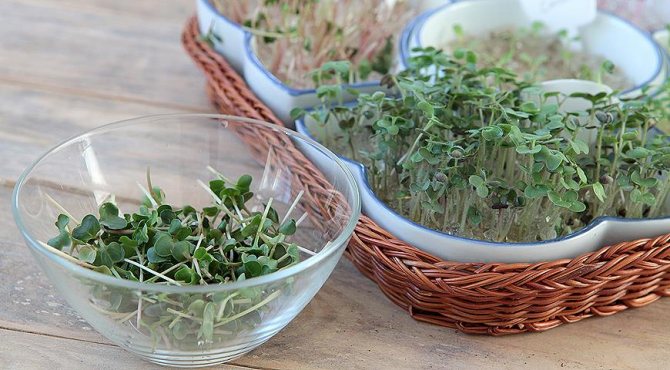

Germinating greens in a hydrogel
Before getting started, prepare:
- seed material;
- hydrogel;
- sowing containers.
After preparing everything necessary, proceed in accordance with the instructions. For the convenience of site visitors, it is shown in the form of a table.
Table. Do-it-yourself greens in a hydrogel.
| Steps, photo | Description of actions |
| Step one | To get started, take the hydrogel balls, put them in a large bowl, fill with water and keep at room temperature for 8 hours. |
| Step two | When the material has swollen, place it in the planting containers. Remove excess liquid (if any) by discarding the balls in a colander. |
| Step three | Spread the seeds over the surface of the hydrogel, but do not cover. Do not wet them in advance - the granules will provide the seed with the amount of moisture necessary for germination. |
| Step four | When the seedlings reach about 4-5 centimeters in size, you can start harvesting. And the containers that have become empty can be used for a new sowing. |
How to water aloe at home
If experienced flower growers know well what conditions aloe needs, then a beginner may find it quite difficult to grow technology and ensure proper care for it. For example, it can be helpful to learn how to water aloe at home.
Seed preparation
After the spring processing of the seed of vegetables or flowers, you can not soil your apartment with earth, but use a hydrogel for this. You need to pour 4-5 liters of hot water with dissolved nutrients, 2 tablespoons of polymer granules. In this case, you must be careful: the amount of fertilizer must be reduced by half the usual dose, so as not to damage the delicate roots of the seedlings.
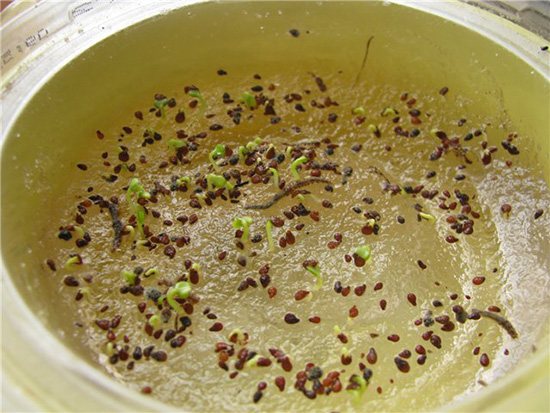

After 2-3 hours have passed, the excess moisture must be drained, and the soaked granules must be placed on a polyethylene film, dried for an hour, and then placed in boxes for seedlings. The seeds are placed on a hydrogel and slightly moistened. The boxes are transferred to the greenhouse, where the young seedlings will be comfortable.
How to grow indoor bamboo: gentle home care
Read about the use of succinic acid for feeding indoor plants in this article.
Instructions
The hydrogel is sold packaged in small plastic zip-lock bags. This is convenient because the plastic fastener makes the packaging reusable. Hydrogel peas will not fall out and get lost. Usually one bag contains granules of the same color. But there are sets that contain multi-colored hydrogel balls. The price of one package is 25 rubles.
The hydrogel balls are poured with water, after placing them in a bowl. The water should be much more than the hydrogel. Do not be alarmed that your balls will get lost and you will never see them again. After 6 hours they will become noticeable, after 12 they can be played. And they will completely swell in a day. Then their diameter will be from 10 to 12 mm.
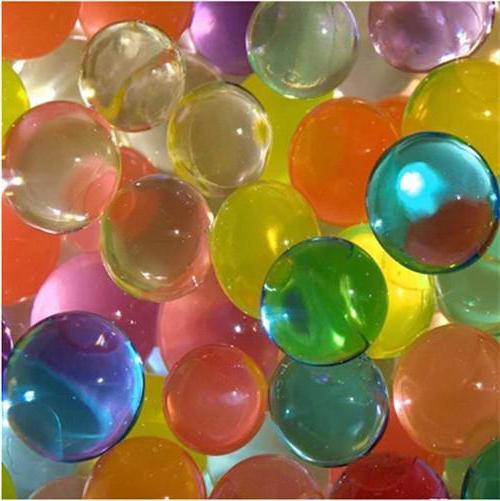

It is not recommended to touch the balls until they swell, otherwise their structure may be disturbed and they will disintegrate when they dry.
Usually a 3-liter can of beautiful shiny balls is obtained from each bag.
Alternative use
Some gardeners practice non-standard alternative uses of the polymer. Such measures make it possible to make plants more decorative, improve crop yields. If you want to add a product to the soil of a rock garden or flower beds, then you should not pierce the ground or dig holes. This can damage the fragile roots of flowers. You can add the hydrogel, just grind it in a coffee grinder. The resulting powder will look like flour. It is mixed with water and the garden is watered at the rate of one and a half grams of funds per 1 m2.
In spring or autumn, when digging the beds, you can also add a product at the rate of 150 grams of substance (powder, granules) per one hundred square meters of the garden. The hydrogel is not afraid of cold winter, and in spring the product will absorb melt water. It will become easier for the gardener to take care of the plantings, the plants will need to be watered less often in spring and summer.
Now read:
- Planting to decorate the site with three types of conifers
- Timely introduction of dolomite flour for the harvest
- Improving and restoring compost with EM-preparation
- Choosing cucumbers for open ground according to your preferences
About
Agronomist of the state agricultural enterprise "Garovskoye" of the Khabarovsk region of the Khabarovsk region.
Varieties and cost of hydrogel
There are two main types of hydrogel:
- a soft, colorless hydrogel designed to grow plants more efficiently;
- a dense, colored hydrogel for plants called aqua primer used in indoor design.
The cost of a hydrogel is influenced by its packaging and manufacturer. High-quality hydrogel for plants can be purchased at Obi hypermarkets.
According to user reviews, one of the most high-quality and popular Russian superabsorbets is Aquasin hydrogel for plants. It is more profitable to purchase a hydrogel for plants in 1 kg packaging, rather than in small sachets.
Agricola hydrogel for plants is also in demand, but it is more for decorative purposes due to its bright colors and dense shape, and is not intended for agriculture.
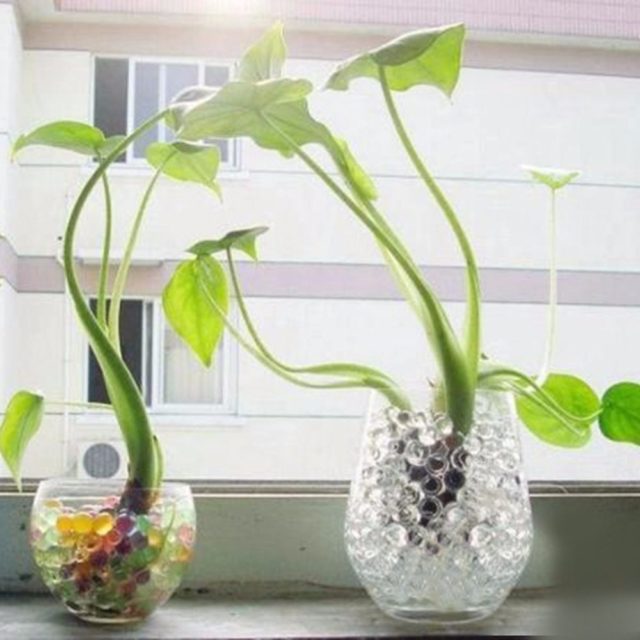

There are two types of hydrogel
Hydrogel: composition
The polymer material or hydrogel of aquasin is called a moisture accumulator. It contains carbon dioxide, ammonium, water. Initially, it is a salt-like crystal. When interacting with water, the granules increase in volume.
For a 100 g jar of crystals, add 20 liters of water. The result is environmentally friendly gel beads. The gel contains potassium and sodium ions, but their content is too low for the polymer to be considered a fertilizer. Its direct function is to accumulate water and liquid fertilizers and give them as needed.
The service life of the gel is 5 years. During this period of time, the polymer material loses its moisture storage properties. For its disposal, soil is used. Since no harmful components are formed during decomposition.
Reviews of young mothers
Mothers of young children leave the most rave reviews about hydrogel balls. They note that playing with them retains the attention of babies much longer than other toys. They even leave the children to play (which is not worth doing), while they go about their own business. How many pellets were eaten during these sessions is unknown. But since the hydrogel beads are not tasty, it can be assumed that not much.
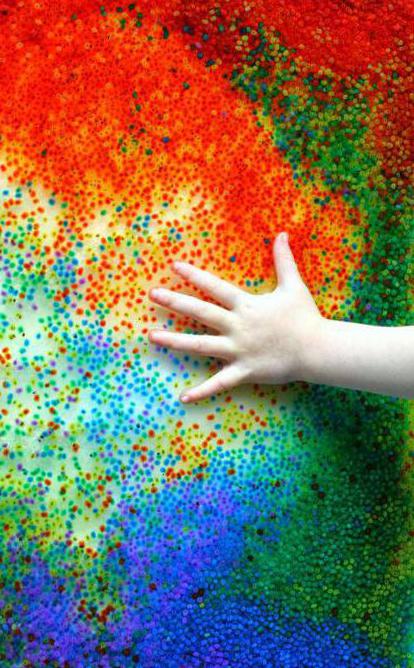

Parents talk about educational games that they play with their children. This is a more rewarding activity. The hydrogel can be especially useful for children with developmental problems.
Is there a benefit: for what purposes is the substance suitable?
Disputes about the usefulness of aqua soil do not stop. Manufacturers claim that it is possible to fully grow plants in it, and experienced florists are sure that this is just a design tool.
We study the composition of the aqua soil
Aqua primer is made on the basis of a hydrogel, which is a polymer, and, accordingly, does not contain any useful substances and microelements necessary for a plant. The function of the composition is solely to absorb liquid and gradually release it to the roots.
In other words, your flowers can get a nutrient medium only from water, which has been absorbed by multi-colored balls, and they, in turn, bring mainly decorative benefits.
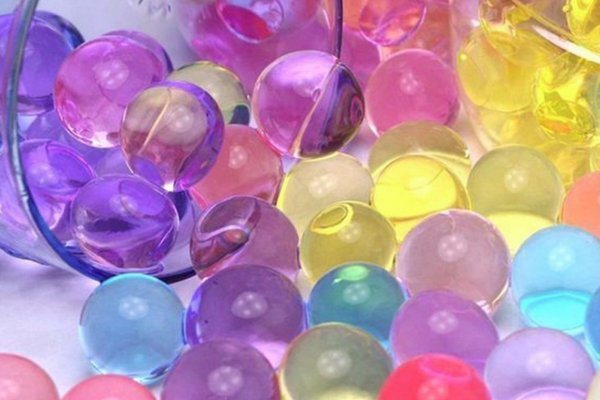

Aqua soil for plants
The manufacturers claim that growing plants in hydrogel beads is not only possible, but also very simple:
- Many growers use this technological advancement to root cuttings. To do this, the aqua soil is prepared in the traditional way, according to the instructions on the package, then cuttings are simply inserted into the vessel with the substrate, which need to be rooted. Compared to the classical placement of cuttings in a glass of water, this method has a definite plus: the cuttings receive moisture in moderation and at the same time does not rot.
Houseplants such as orchid, crossandra, kalanchoe, sheflera, campanula, pachistachis, ficus, dracaena, azalea, petunia, streptocarpus, hypoestes, dieffenbachia, argirantemum and royal geranium are propagated by cuttings. - Some home flower lovers practice hydroponic growing of flowers without the use of soil substrates, exclusively in a hydrogel. This process requires a careful assessment of the condition of the plants and does not always give the desired result. Nevertheless, when breeding flowers that grow in wildlife according to the principle of hydroponics, for example, orchids, they use aqua soil quite safely. In this case, the plant is not completely immersed in the balls and is in a pot with the usual bark substrate, and the pot, in turn, is placed in a vessel with prepared aqua soil. This reduces the risk of decay of the root system of the flower and the necessary moisture of the substrate is achieved.
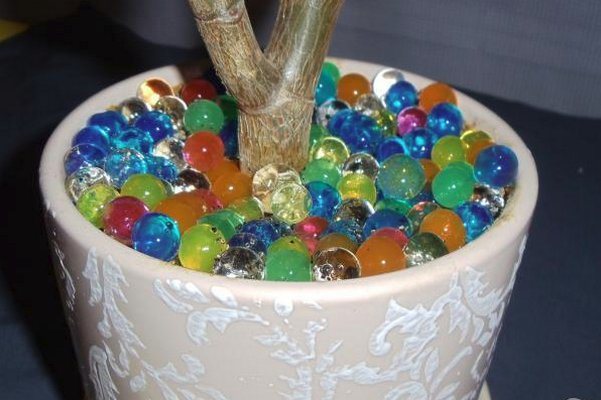

Aqua soil for flowers in bouquets
Aqua primer is ideal for cut flowers in a bouquet. A fresh bouquet of flowers in a vase filled with multi-colored transparent balls looks very beautiful.
We advise you to read about how to keep roses, peonies, tulips and lilacs in a vase longer.
Even capricious bouquets of roses or tulips will be better preserved in such a mixture, since they will receive a sufficient amount of moisture and at the same time the cut will not rot.
Important! When placing bouquets in aqua soil, you need to remember that the substrate must be thoroughly rinsed every 2 days under running water, like the flower stems themselves. This is necessary in order to remove the formed organic mucus and to avoid the appearance of an unpleasant odor in the vase.
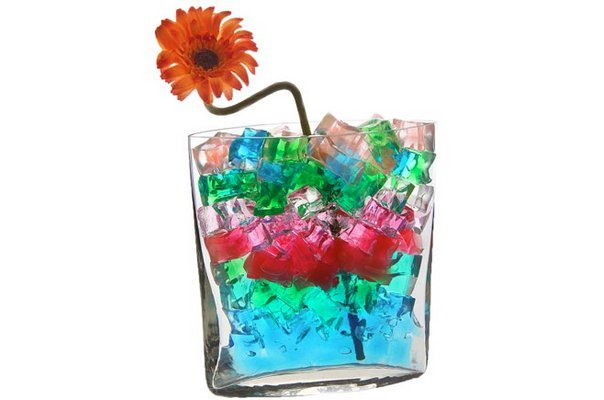

Description
Hydrogel balls are small peas of bright color. They are similar in size to peppercorns. Their diameter is about 2 mm. But after the balls have lain in water for some time, they swell and increase tenfold. They become soft, firm and pleasant to the touch. They can be reduced by laying in a sunny location.
Under the influence of its rays, they gradually lose their bright color. Therefore, they can be used a certain number of times. Then you need to buy new hydrogel beads.
Why do you need a hydrogel?
The effect of a hydrogel on plant growth is its ability to accumulate liquid, which it gradually transfers to plants. Explaining why a hydrogel for plants is needed, it should be noted that its use makes it possible to avoid both drying of plants and rotting of their root system from excessive watering. Also, the hydrogel helps to reduce the stress of young plants when planting seedlings or seedlings in the ground. Hydrogel can be used as a replacement for frequent watering of indoor plants, which will even allow you to leave for a couple of weeks without worrying that the plants will dry out and die.
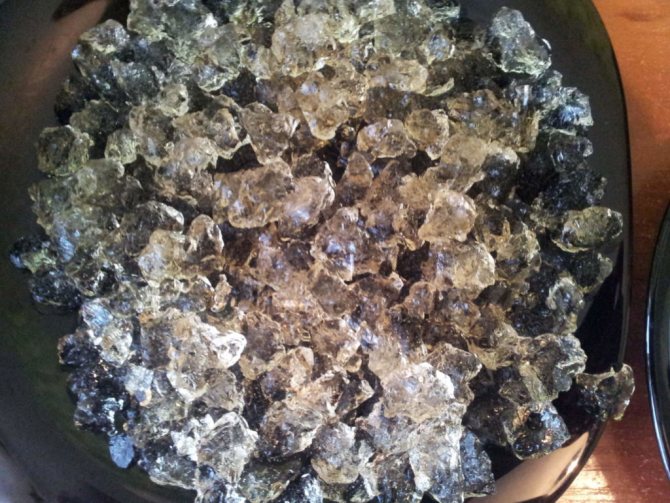

The use of a hydrogel will help to avoid a lack of moisture in plants.

